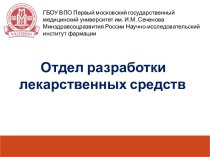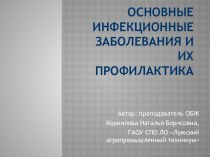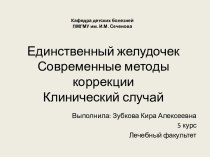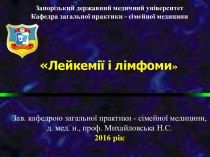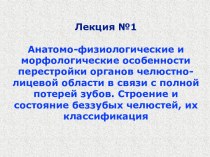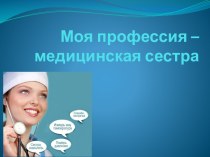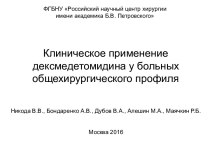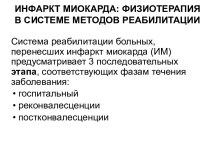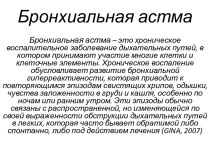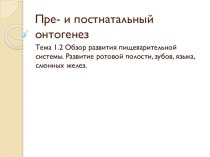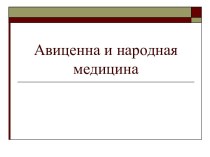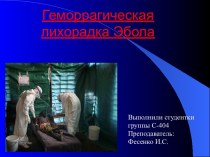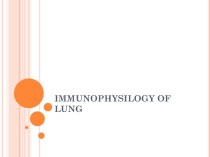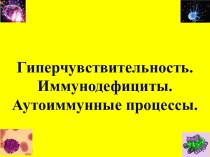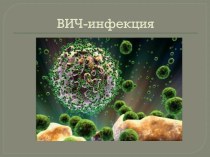- Главная
- Разное
- Бизнес и предпринимательство
- Образование
- Развлечения
- Государство
- Спорт
- Графика
- Культурология
- Еда и кулинария
- Лингвистика
- Религиоведение
- Черчение
- Физкультура
- ИЗО
- Психология
- Социология
- Английский язык
- Астрономия
- Алгебра
- Биология
- География
- Геометрия
- Детские презентации
- Информатика
- История
- Литература
- Маркетинг
- Математика
- Медицина
- Менеджмент
- Музыка
- МХК
- Немецкий язык
- ОБЖ
- Обществознание
- Окружающий мир
- Педагогика
- Русский язык
- Технология
- Физика
- Философия
- Химия
- Шаблоны, картинки для презентаций
- Экология
- Экономика
- Юриспруденция
Что такое findslide.org?
FindSlide.org - это сайт презентаций, докладов, шаблонов в формате PowerPoint.
Обратная связь
Email: Нажмите что бы посмотреть
Презентация на тему Endocrine system in children
Содержание
- 2. Endocrine system of regulation means endocrine glands’
- 3. Hormones are peculiar envoys, commands, coded by
- 4. There is general conformity to the law
- 5. Organization of hormonal management in an organism
- 6. The feedback principle – in condition of
- 7. Endocrine glands possessing an intra-secretory function include
- 8. Each of the endocrinal glands possesses a
- 9. The main organizing center which provides regulation
- 10. Efficiency of hypothalamus` work is explained that
- 11. The system of the endocrine regulation depends
- 12. The features of endocrine system in different periods of childhood.
- 13. Most endocrine glands' organogenesis and the hypothalamus`
- 14. From positions of embryology it is necessary
- 15. The fetal development especially on an early
- 16. Benign gynecomastia in a newborn due to hyperestrogenemia in a mother.
- 17. The endocrine diseases of mother with high
- 18. In prenatal period the hypophysis and thymus
- 19. The essence of endocrine regulation in human
- 20. Principles on which the clinical research
- 21. 3/ Detection of abnormal organs’ and cells-targets’
- 22. Description of ductless glands in children, effects
- 23. Hypothalamus.Hypothalamus is the part of cerebral trunk
- 24. The innate structural abnormalities of hypothalamus, as
- 25. Semiotics of hypothalamic lesions. The hypothalamic
- 26. Hypophysis (pituitary cerebri).The pituitary gland is also
- 27. The anterior hypophysial lobe (anterior pituitary) produces
- 28. What is the physiological role of STH
- 29. The posterior hypophysial lobe (posterior pituitary) is
- 30. Semiotics of pituitary gland’s
- 31. The anterior hypophysial lobe’s hyperfunction (commonly
- 32. Cerebral gigantism in an 8-yr-old boy. The
- 33. If the hormonal active adenoma of anterior
- 34. The hypofunction of anterior lobe of pituitary
- 35. The common functional disturbances of anterior hypophysis
- 36. Hypophysail posterior lobe’s dysfunction. Due to insufficient
- 37. Objective visiul stady of the pituitary gland
- 38. Roentgenograph of the skull of
- 39. Adrenal glands Adrenal cortex produces more than
- 40. The production of cortico - and mineralocorticosteroids
- 41. The role of adrenal glands’ sexual hormones
- 42. At the beginning of pubertal stage (approximately
- 43. Semiotics of adrenal cortex’ lesionAbout adrenal
- 44. The acute adrenal insufficiency syndrome The signs
- 45. The abnormally increased function of adrenal cortex
- 46. The genetically determined disturbances with hyperproduction of
- 47. In neonatal adreno-genital syndrome the sex determination can be difficult.
- 48. In elder age (between 3 and 8
- 49. Semiotics of selective lesion of suprarenal
- 50. Thyroid glandThe thyroid gland synthesizes two
- 51. Thyroid gland functional insufficiency Thyroid gland functional
- 52. The clinical manifestations of congenital hypothyroidism appear
- 53. The late symptoms of innate hypothyroidism,
- 54. Congenital hypothyroidism in an infant 6 mo
- 55. Among additional confirmatory investigations the X-Ray symptome
- 56. Rickets in a 2-year-old child presenting with
- 57. The laboratory study confirms the diagnosis. The
- 58. Hyperthiroidisms (exophthalmic goitre, Graves’ disease, thireotoxicosis and
- 59. Onycholysis associated with hyperthyroidism
- 60. The sizes and other characteristics of thyroid
- 61. Parathyroid glandsParathyroid glands are derived from
- 62. Functional insufficiency of parathyroid glands (due to
- 63. Innate hyperparathyroidism is accompanied by hypercalcemia with
- 64. The hypertrophy (hyperplasia) of thymus if it
- 65. Epiphysis (pineal gland).In children the epiphysis
- 66. PancreasPancreas as an organ of endocrinal
- 67. Gonadial glands development and puberty.Boys’ puberty.
- 68. Sequence of maturational events in males.
- 69. Sex maturity ratings of pubic hair development
- 70. Puberty in girls.Period of puberty in girls
- 71. The girls aged approximately 14,5 - 15
- 72. What parts of the hypophysis (pituitary) do
- 73. What parts of the hypophysis (pituitary) do
- 74. What hormone does the thyroid gland secrete?
- 75. What hormone does the thyroid gland secrete?
- 76. Which hormone is secreted by the hypothalamus
- 77. Which hormone is secreted by the hypothalamus
- 78. Adrenal medulla produces: А. Adrenalin В. Noradrenalin
- 79. Adrenal medulla produces: А. Adrenalin В. Noradrenalin
- 80. In children with congenital hypothyroidism the serum
- 81. In children with congenital hypothyroidism the serum
- 82. A 1-day-old full-term neonate assessed as a
- 83. A 1-day-old full-term neonate assessed as a
- 84. Ocular manifestation of Graves disease (thyreotoxicosis) include
- 85. Ocular manifestation of Graves disease (thyreotoxicosis) include
- 86. A 3-mo-old infant has feeding problems, lethargy,
- 87. A 3-mo-old infant has feeding problems, lethargy,
- 88. Congenital hypoparathyroidism is associated with:hypocalcaemia hyponatremia hypoglycemia hyperbilirubinemia hypokalemia
- 89. Congenital hypoparathyroidism is associated with:hypocalcaemia hyponatremia hypoglycemia hyperbilirubinemia hypokalemia
- 90. All of the following may be manifestations
- 91. Скачать презентацию
- 92. Похожие презентации
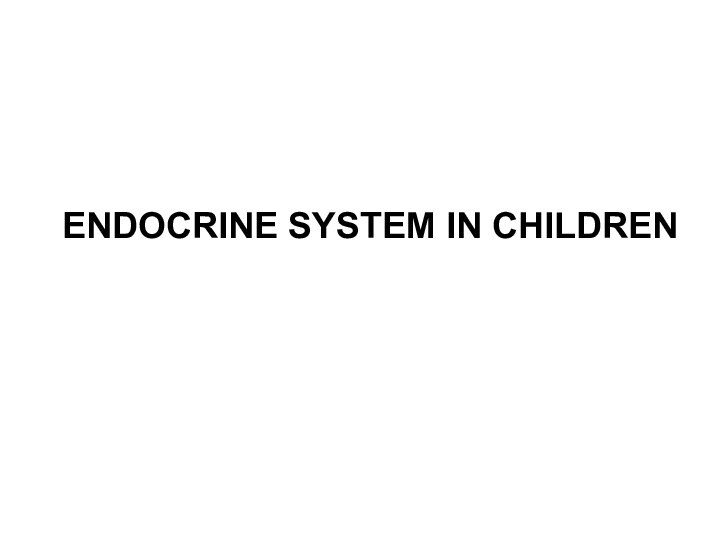


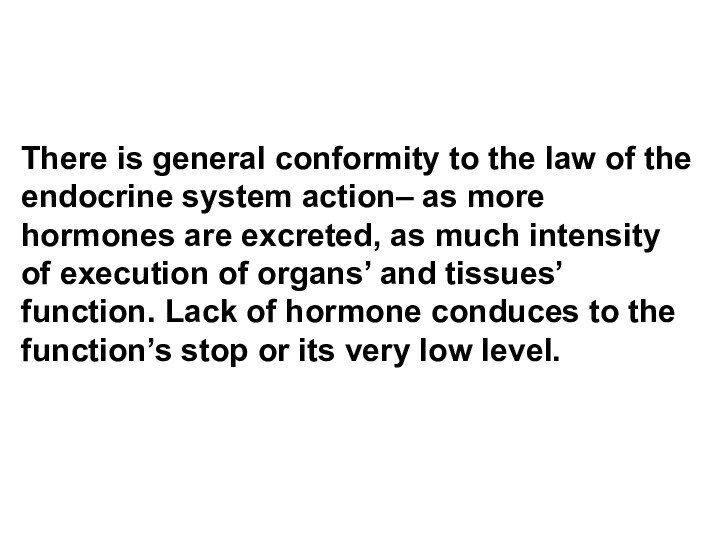


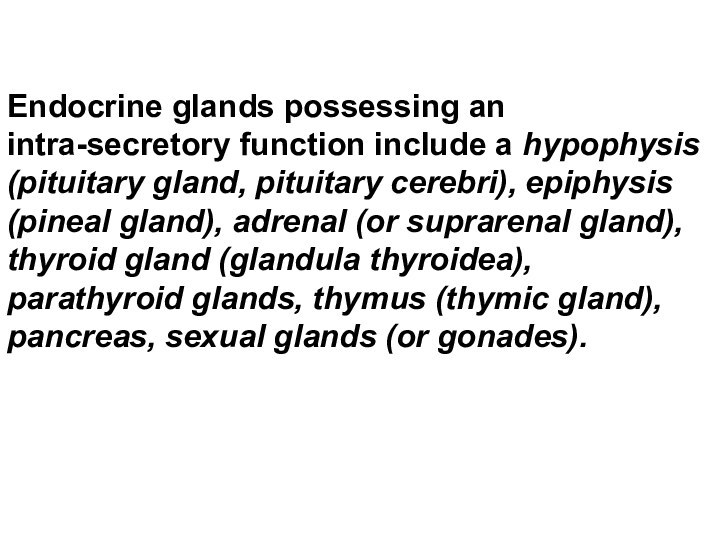
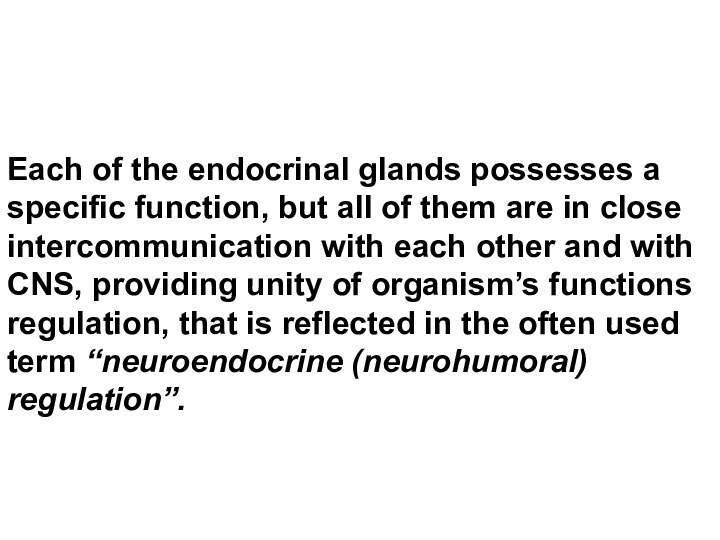
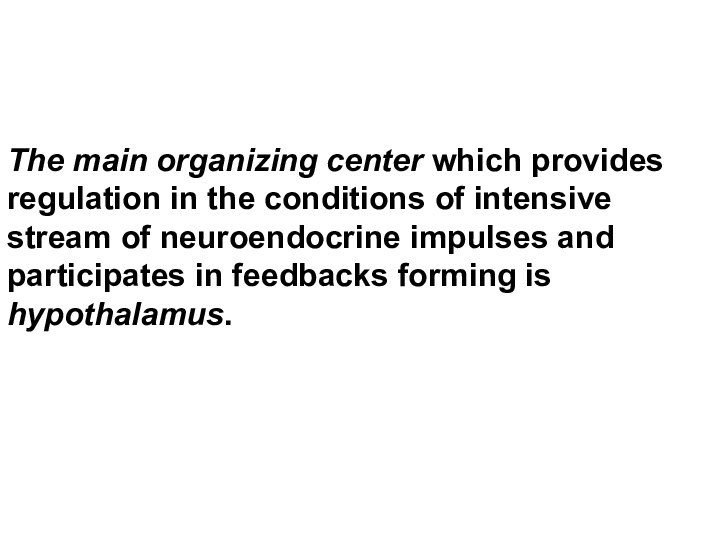

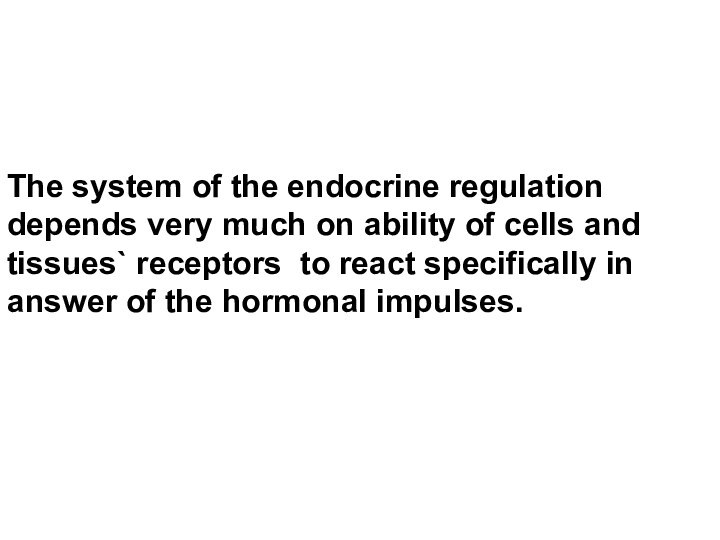

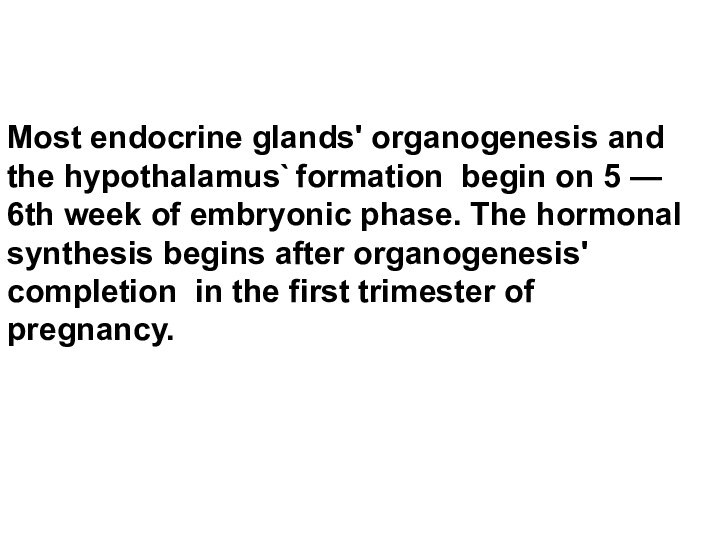
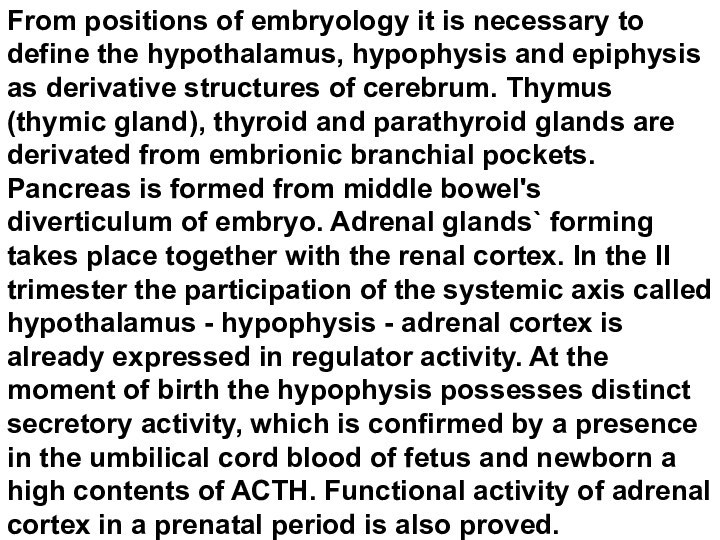
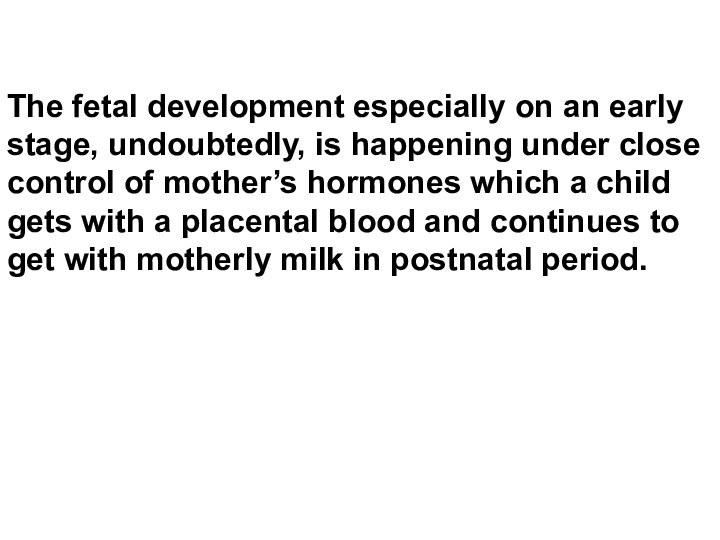

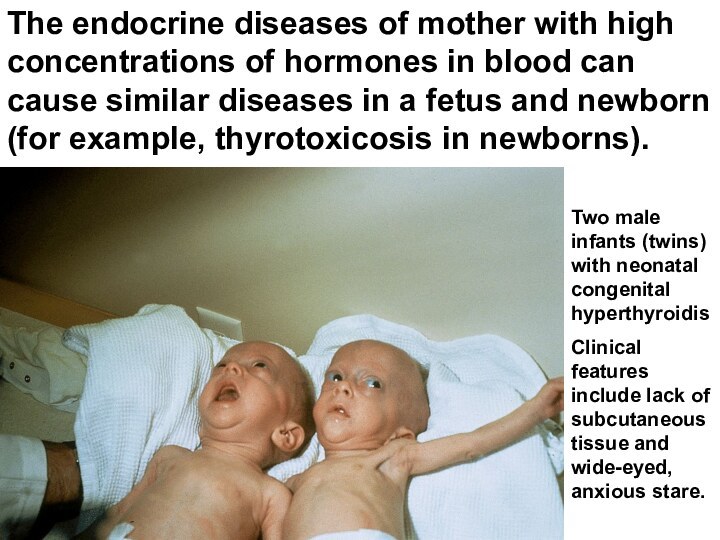
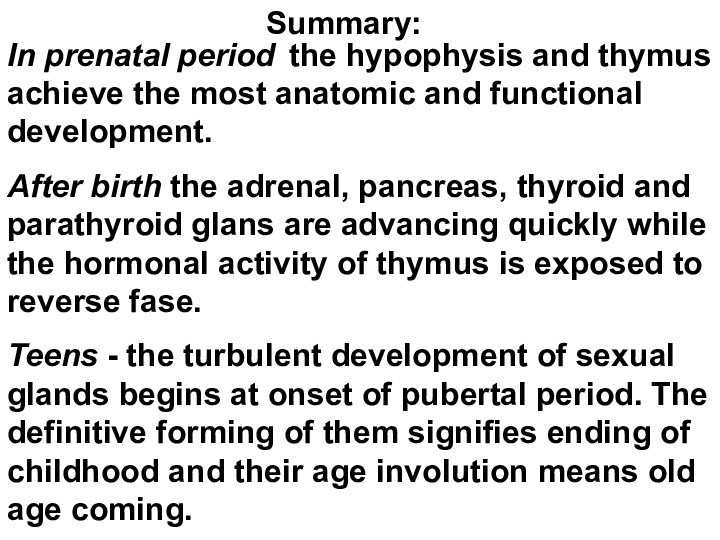

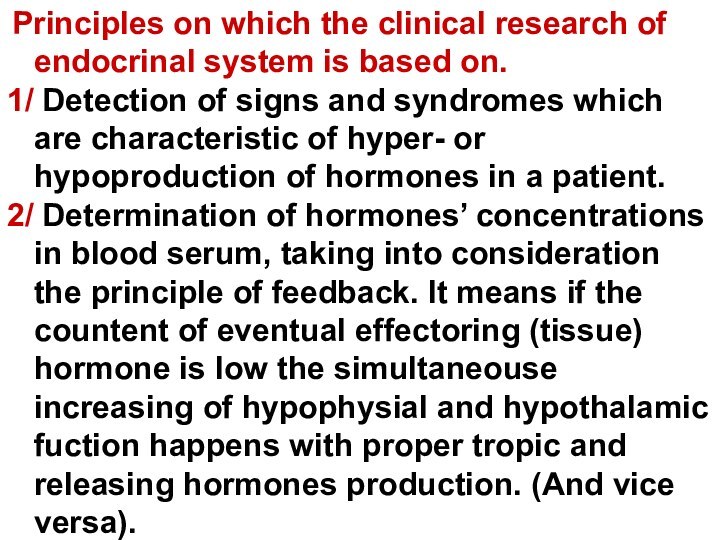

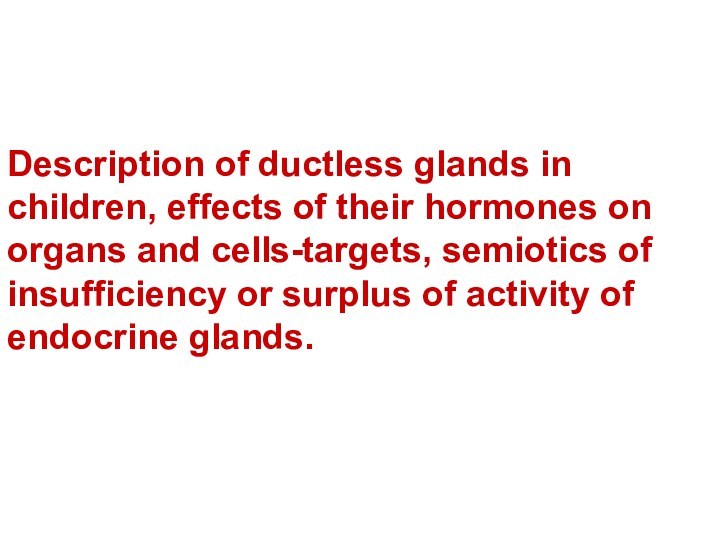
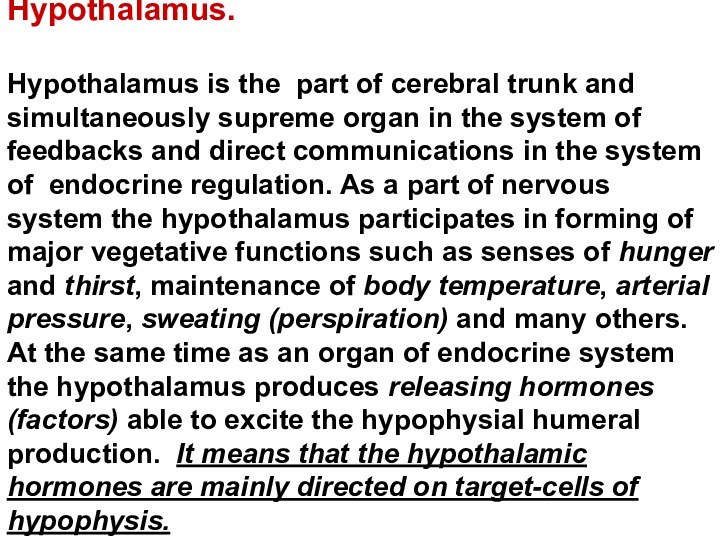
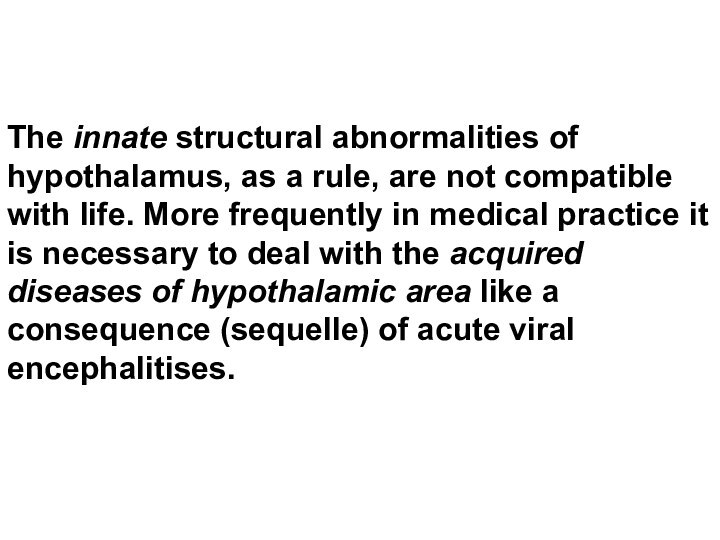


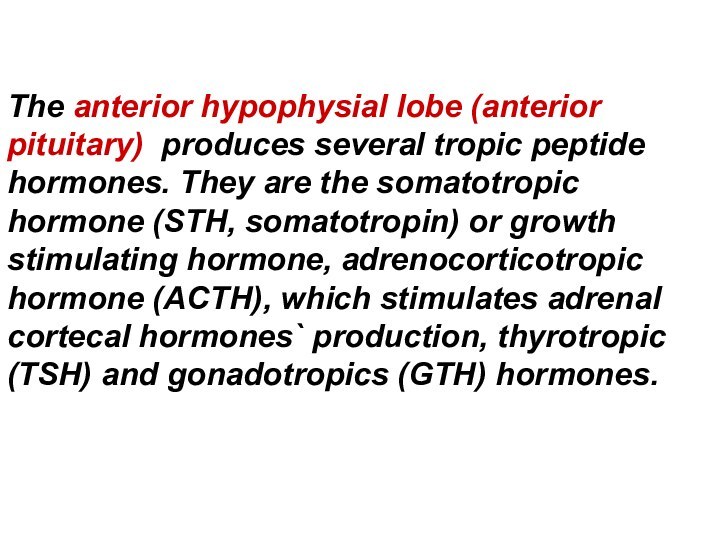
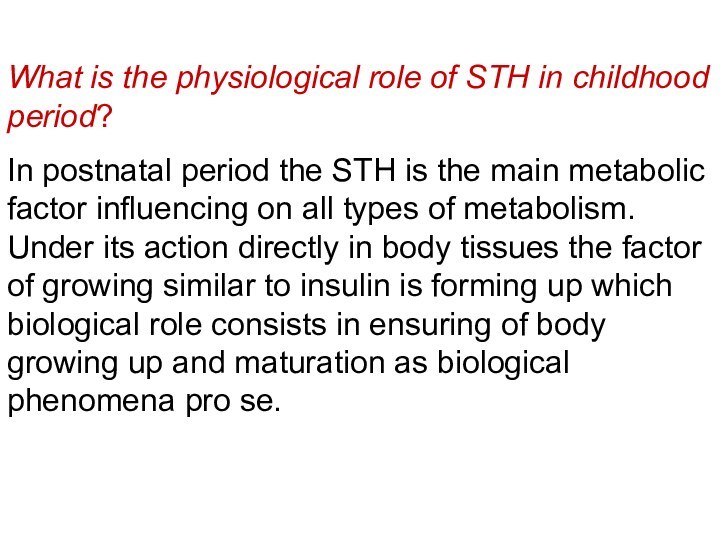
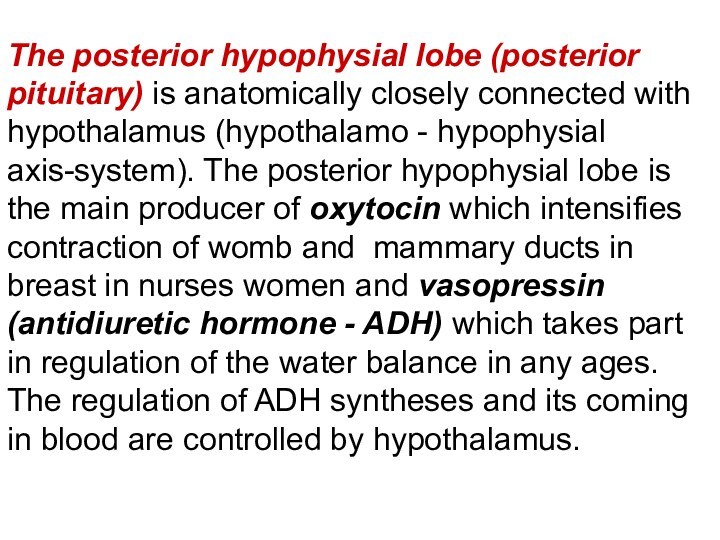
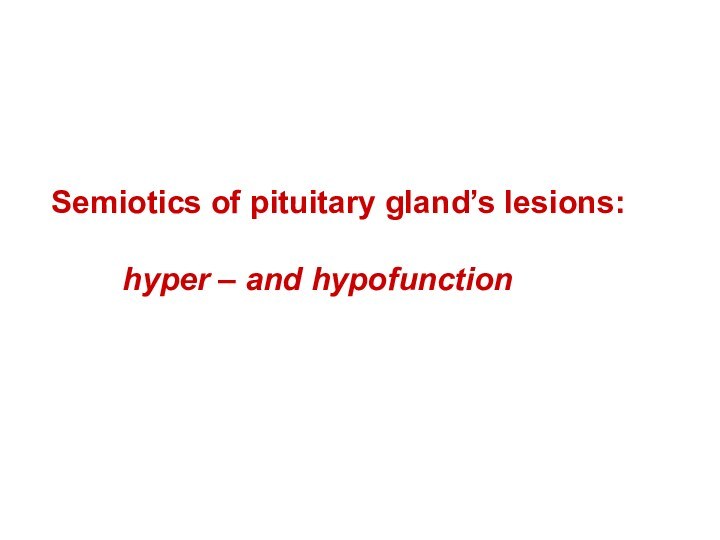
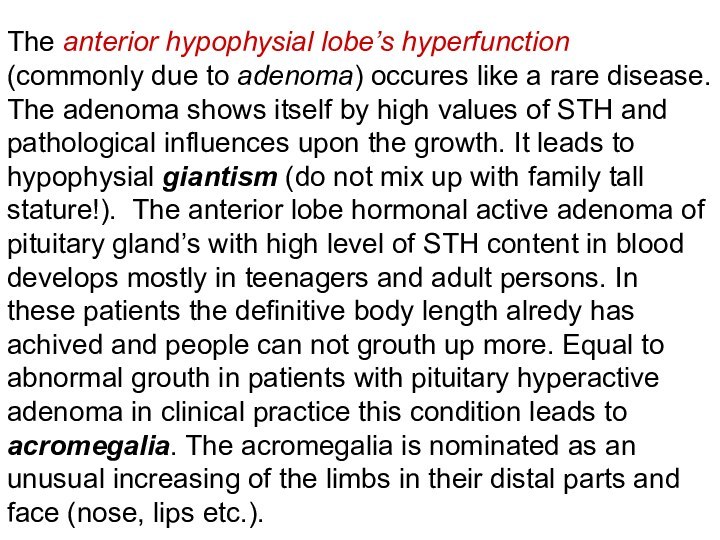
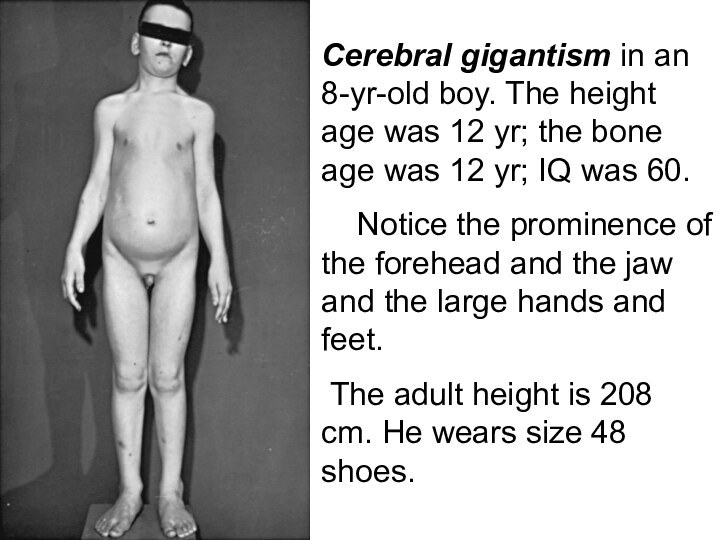

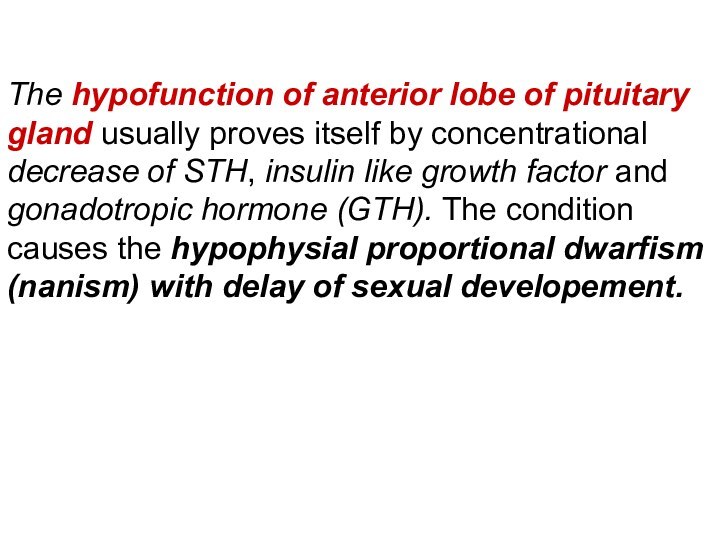
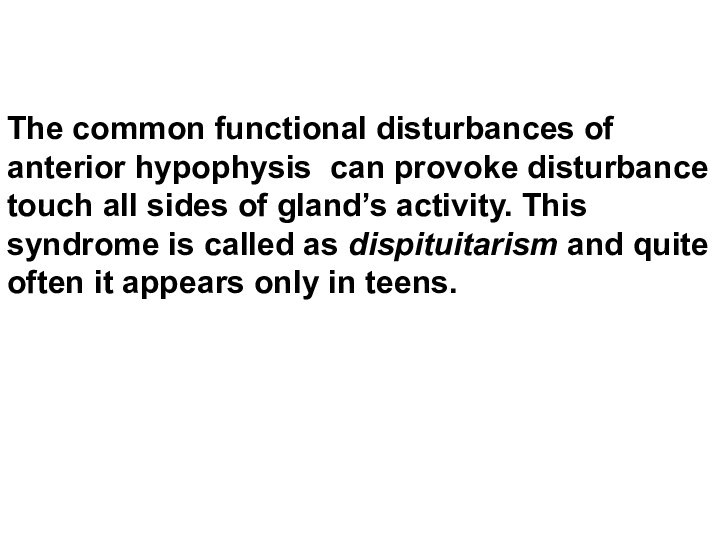
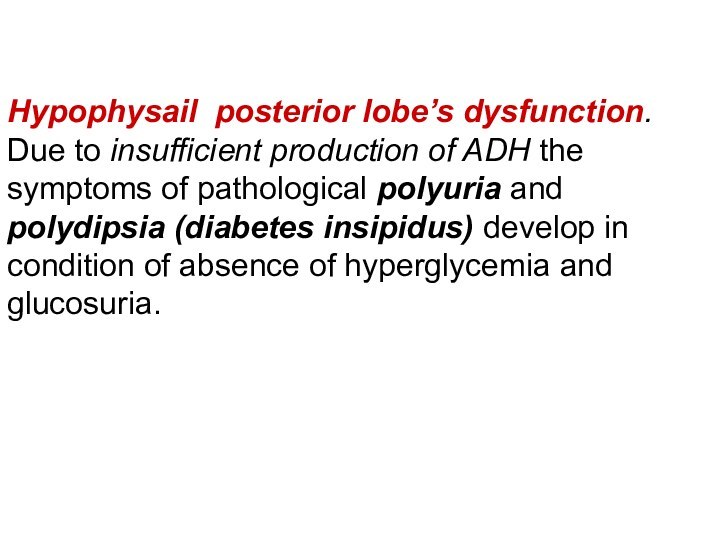
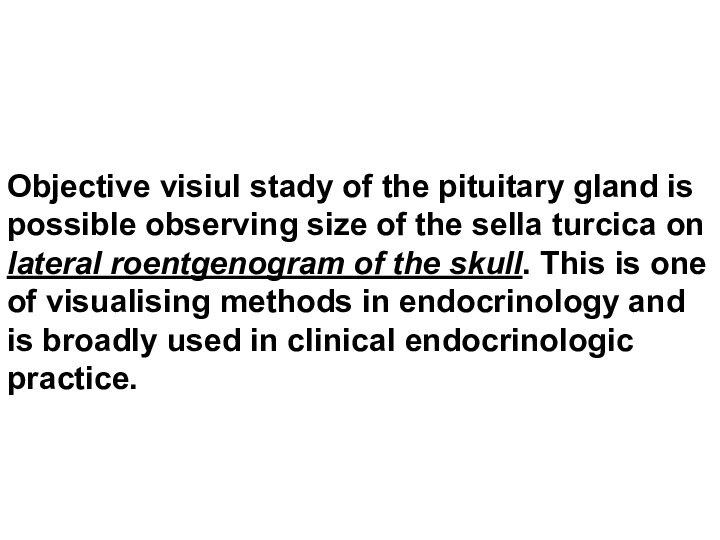
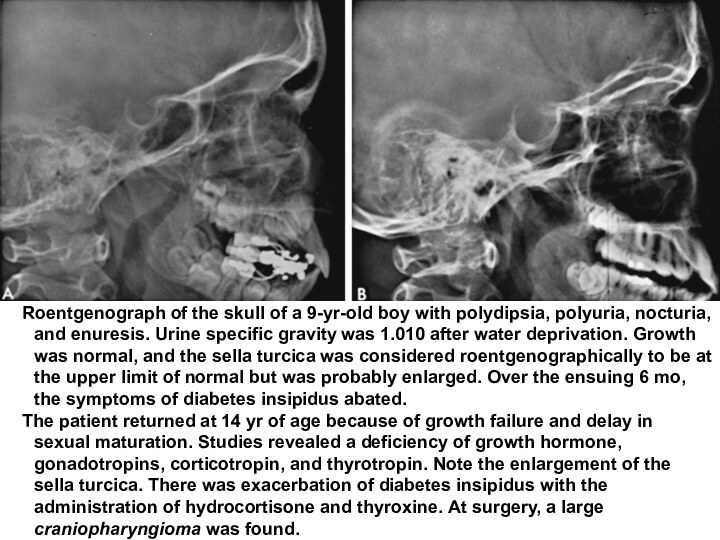

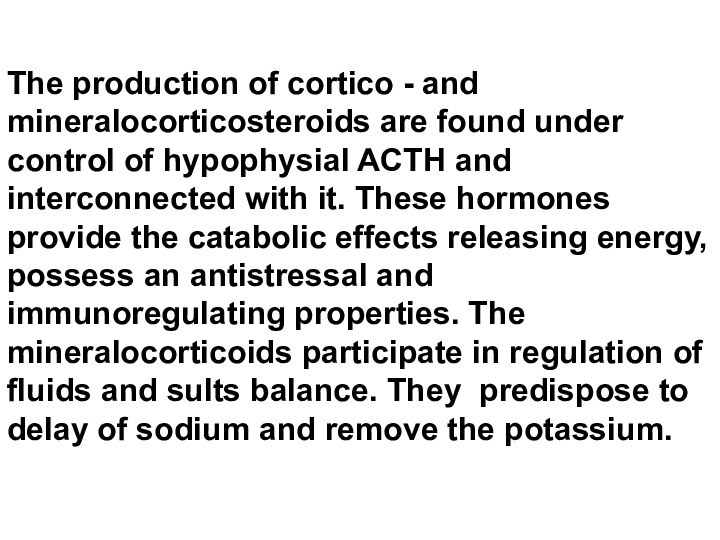
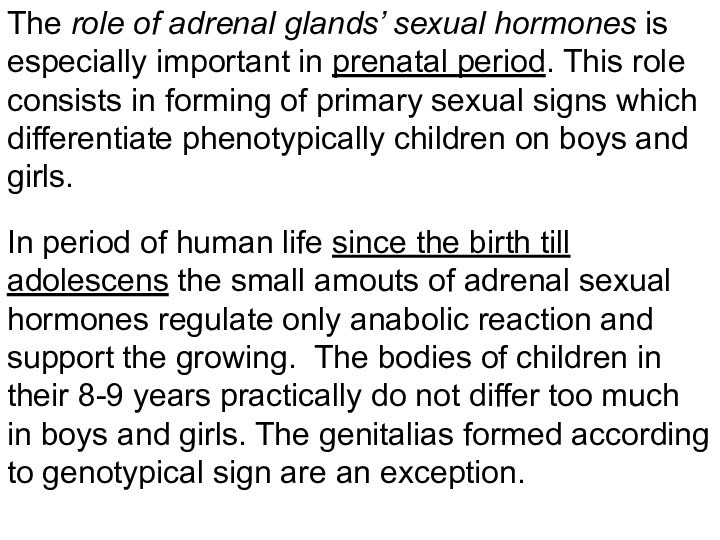
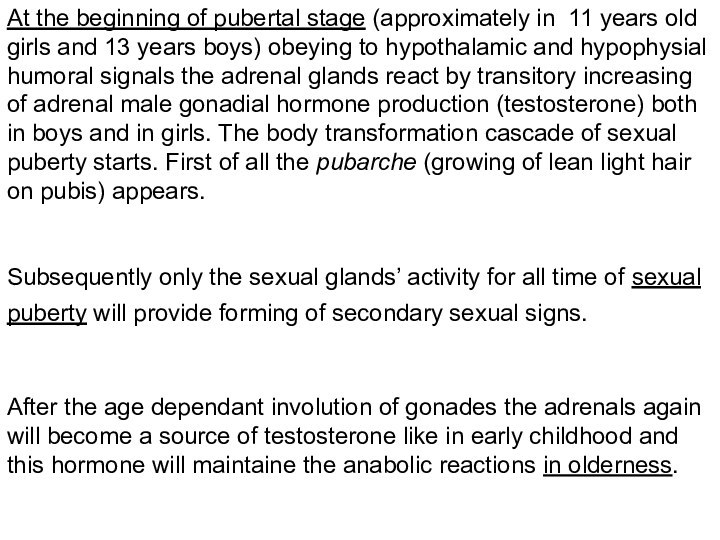
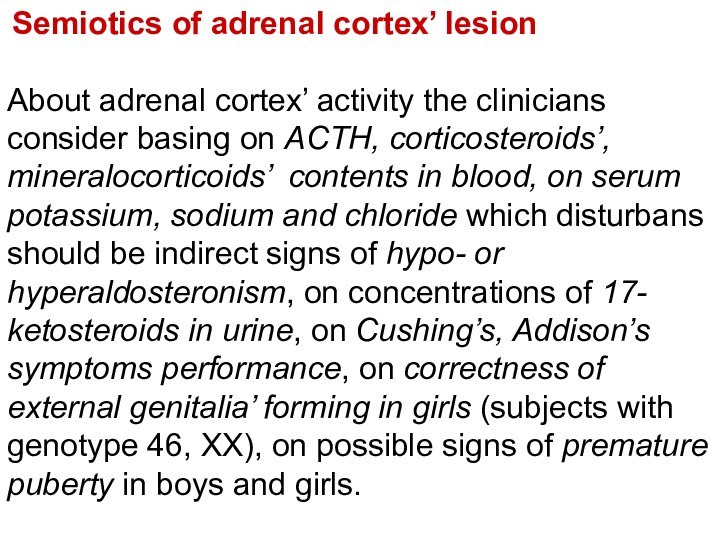

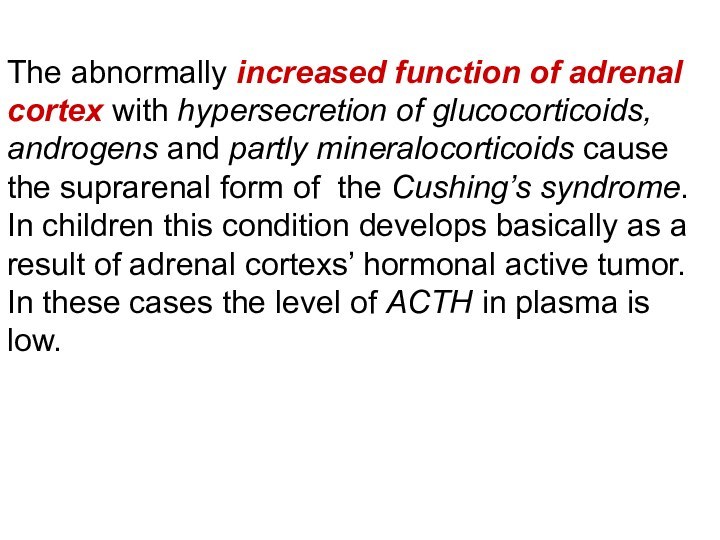
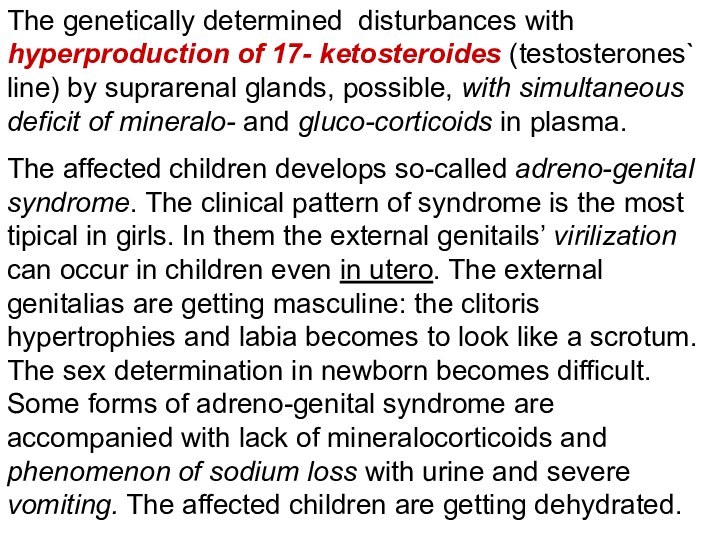
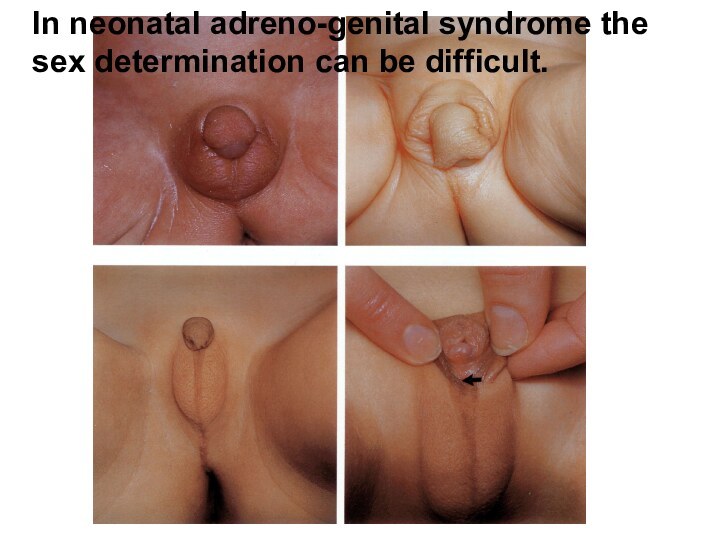

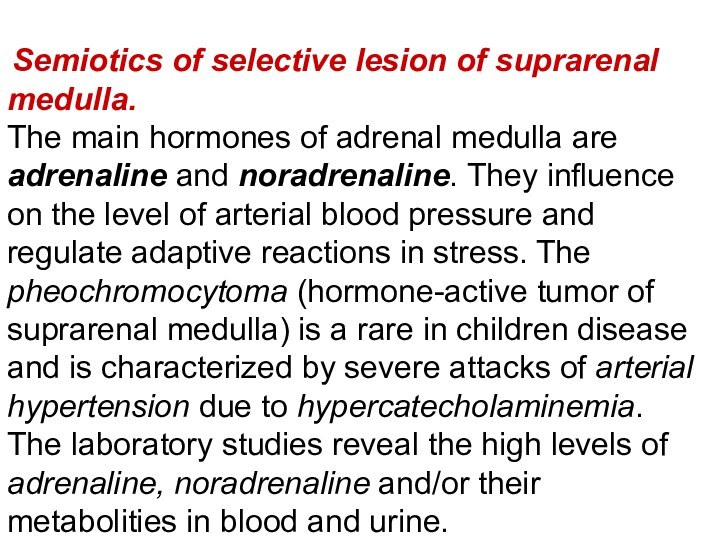

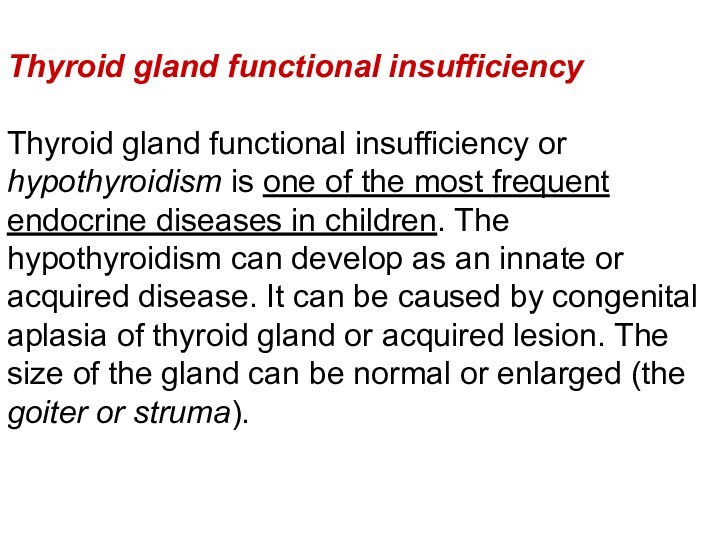
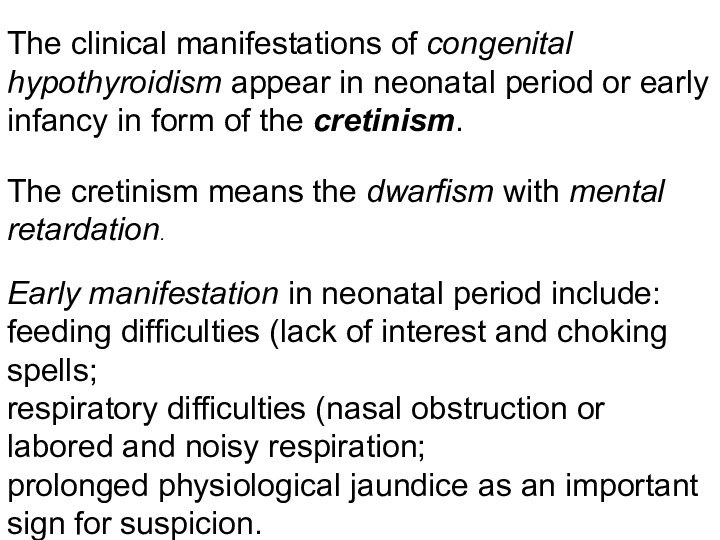
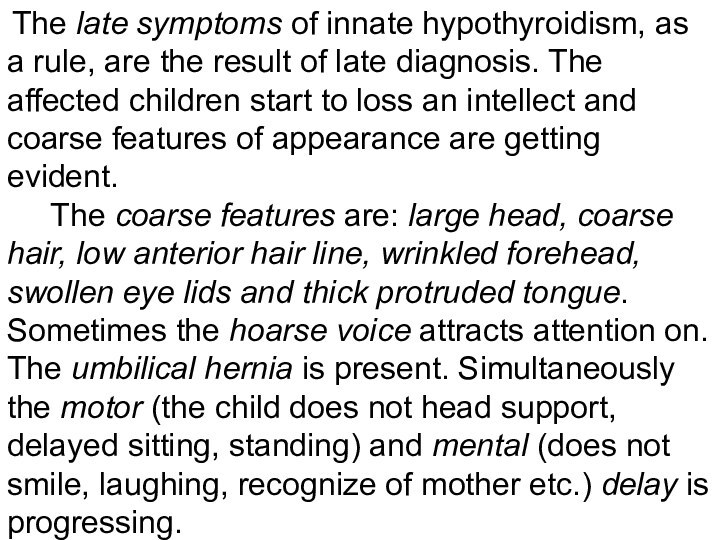
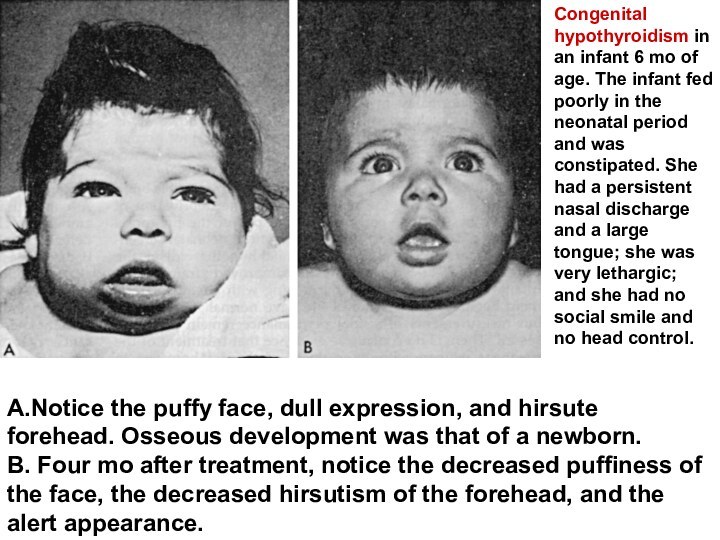

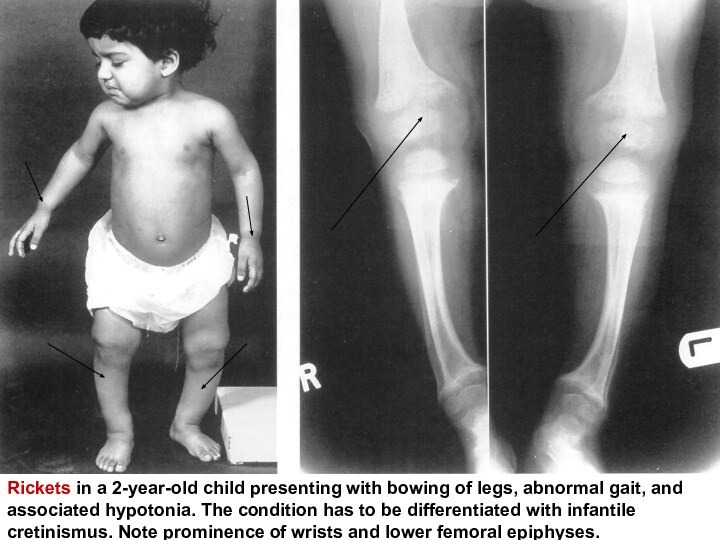
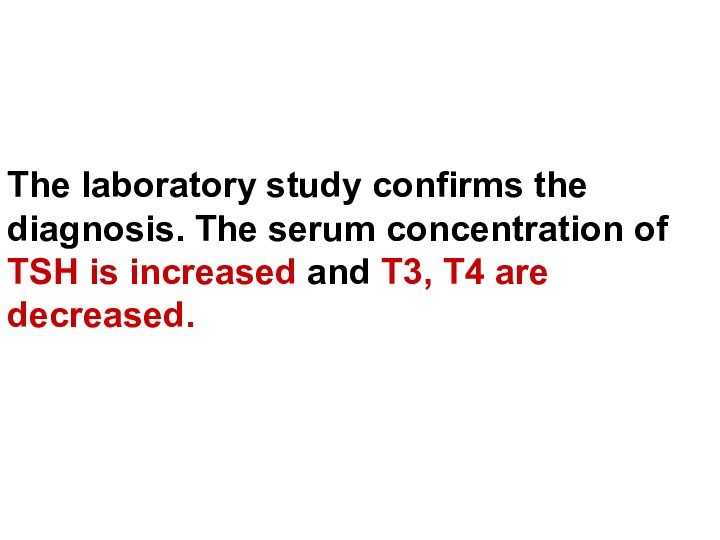
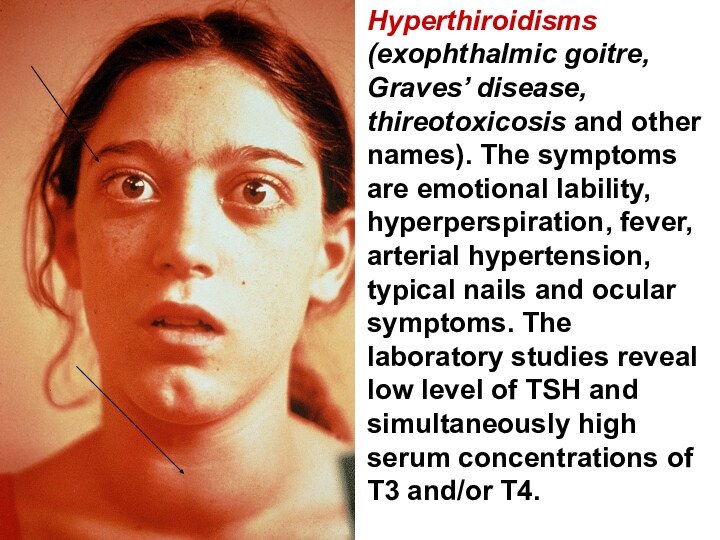
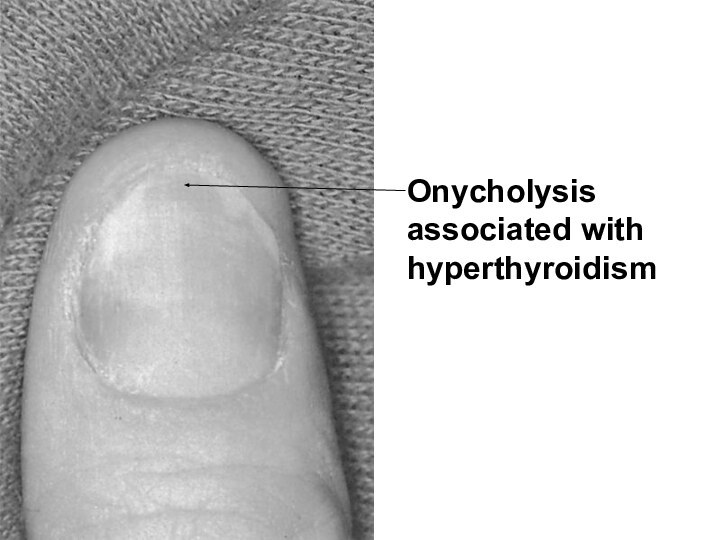
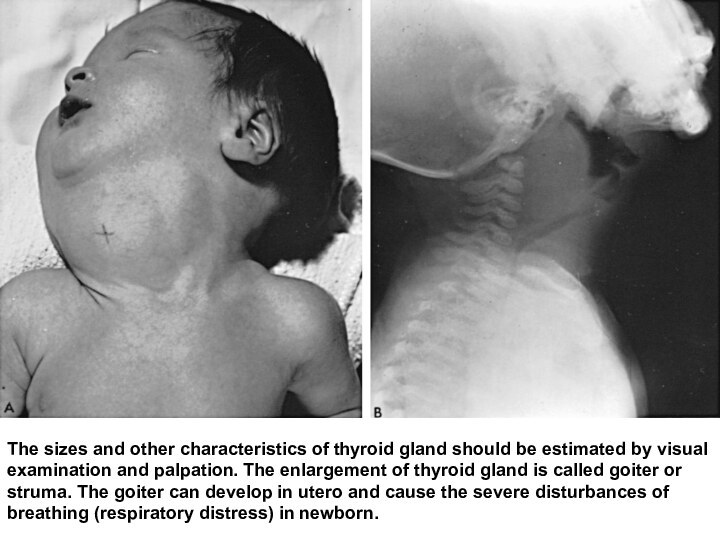

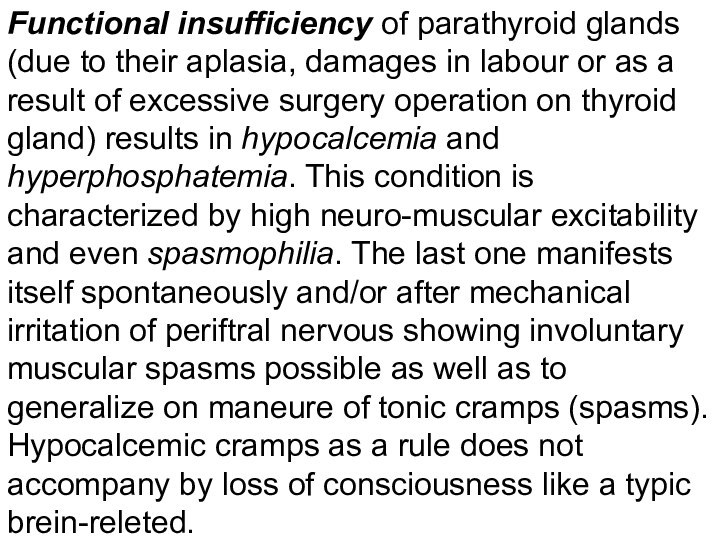



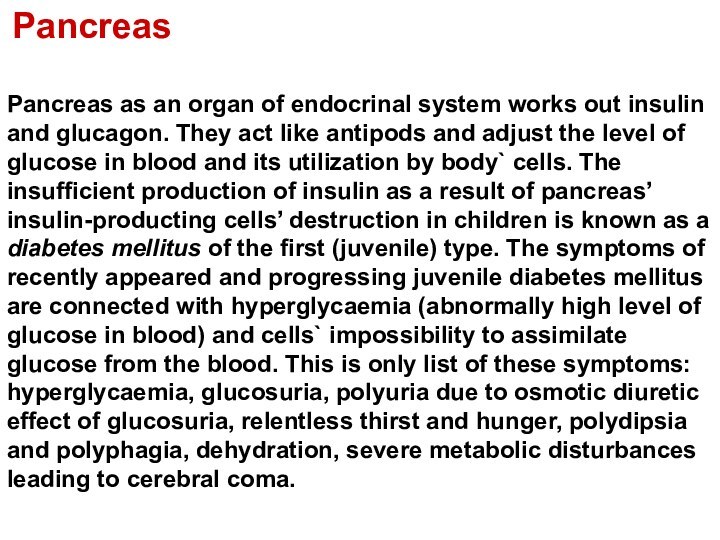
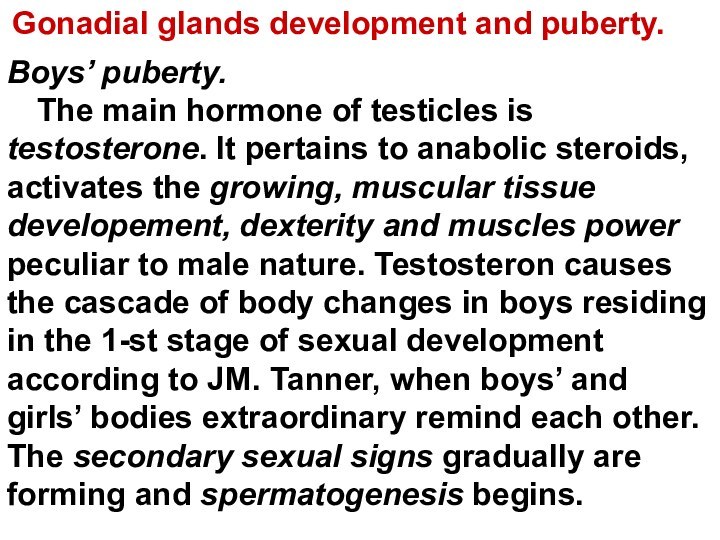
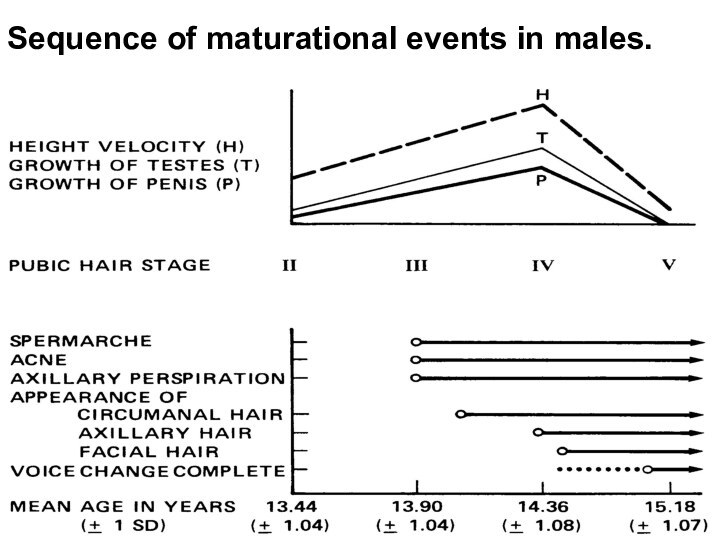
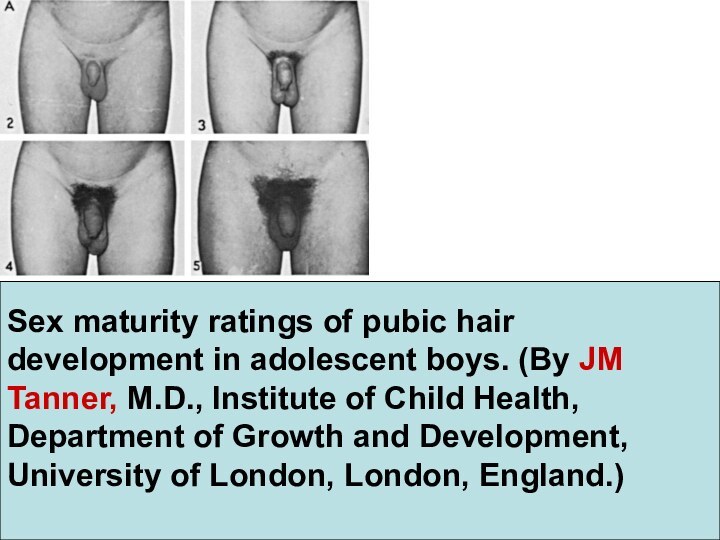



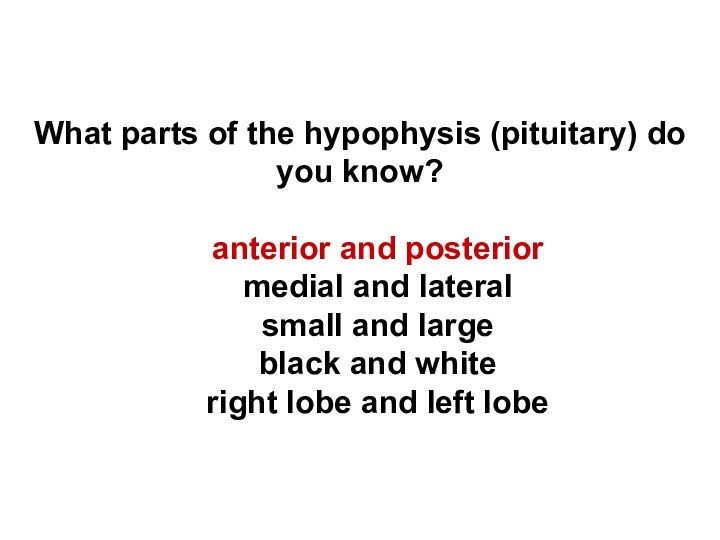

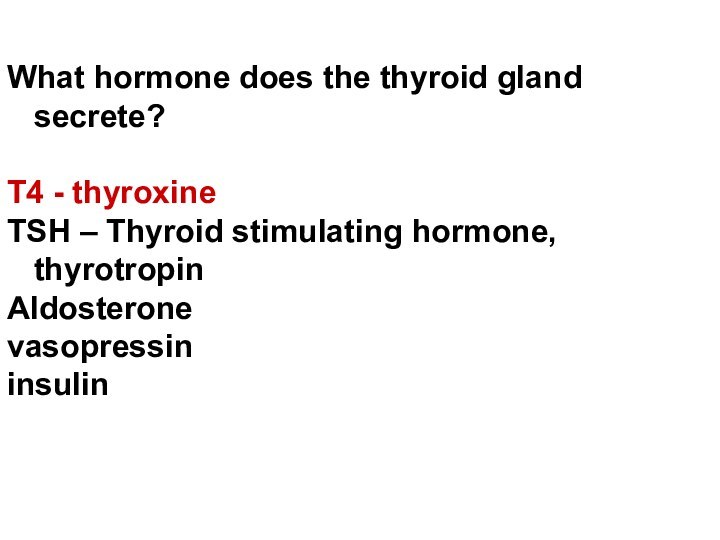
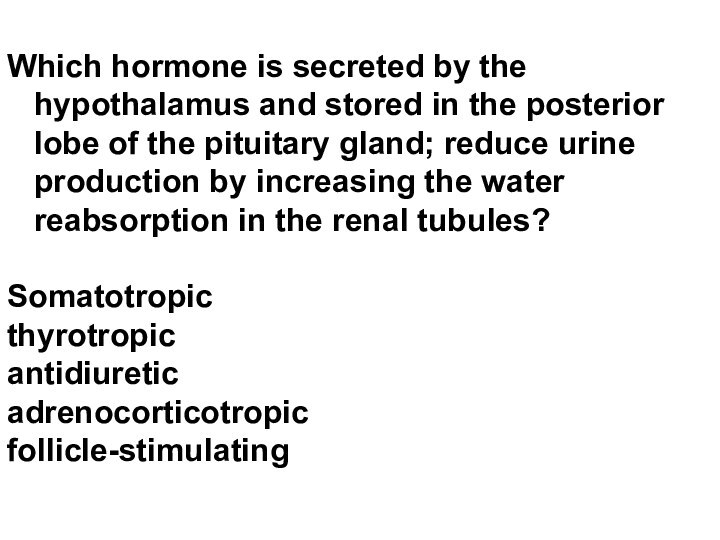
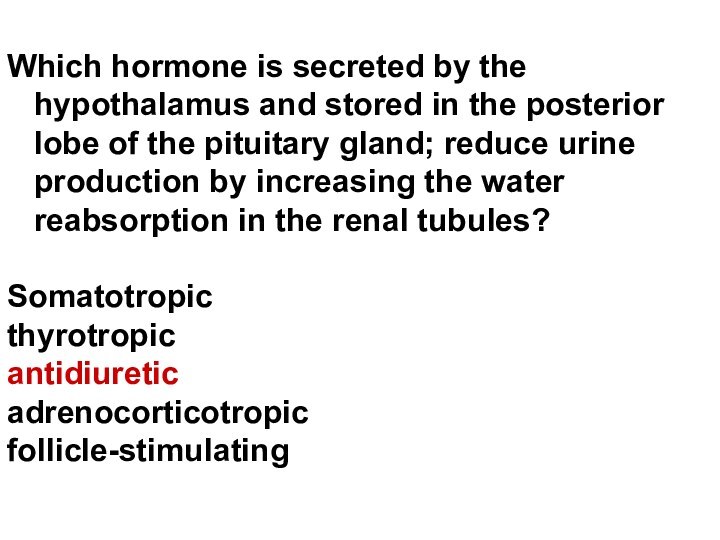

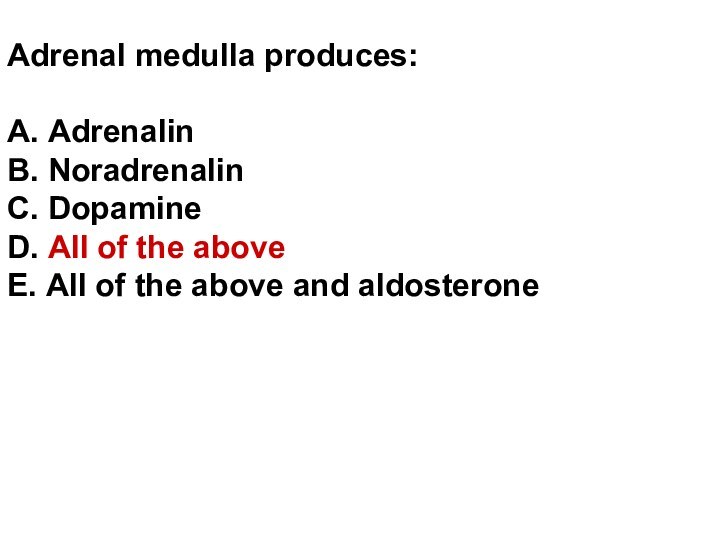
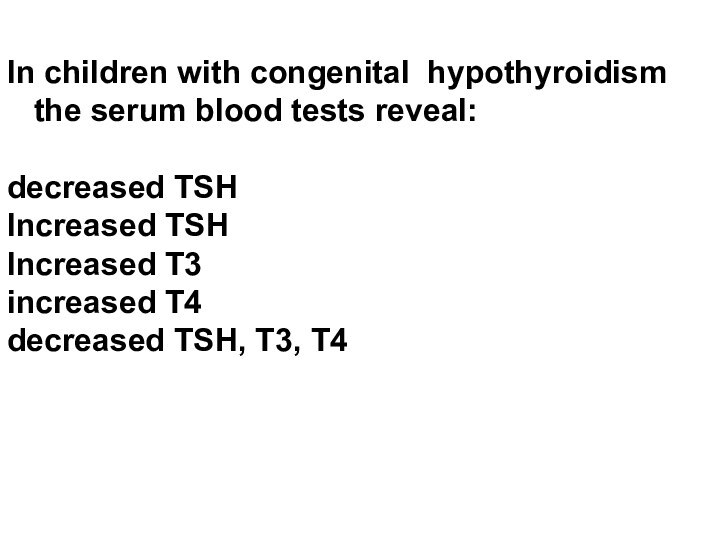
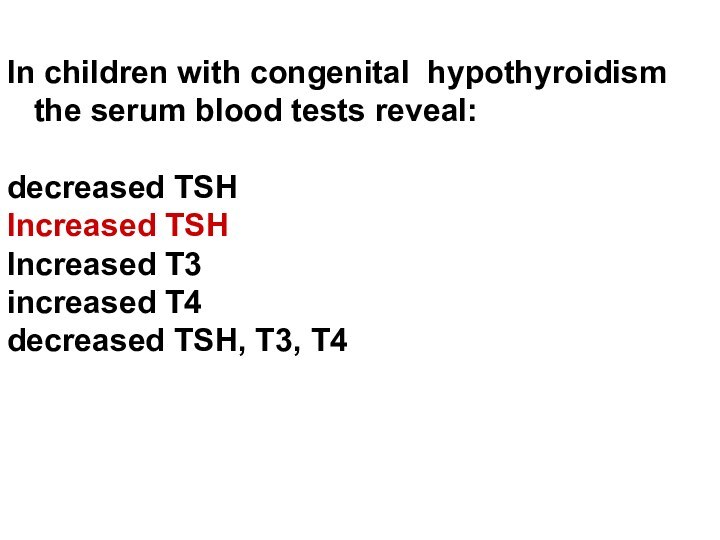
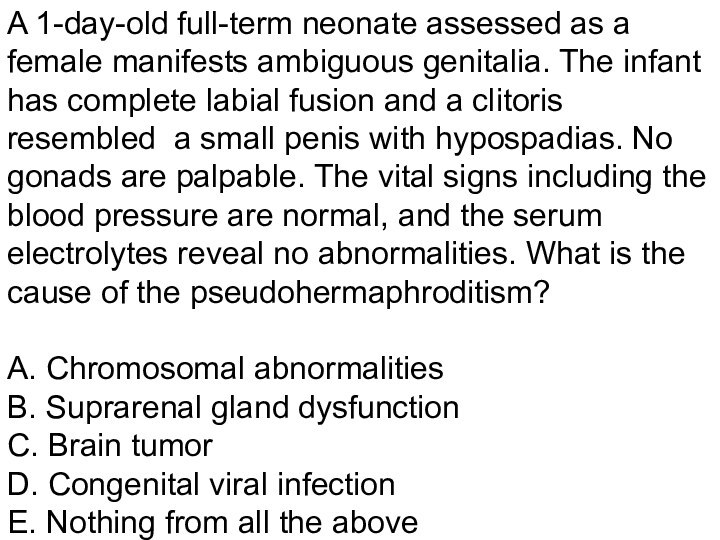
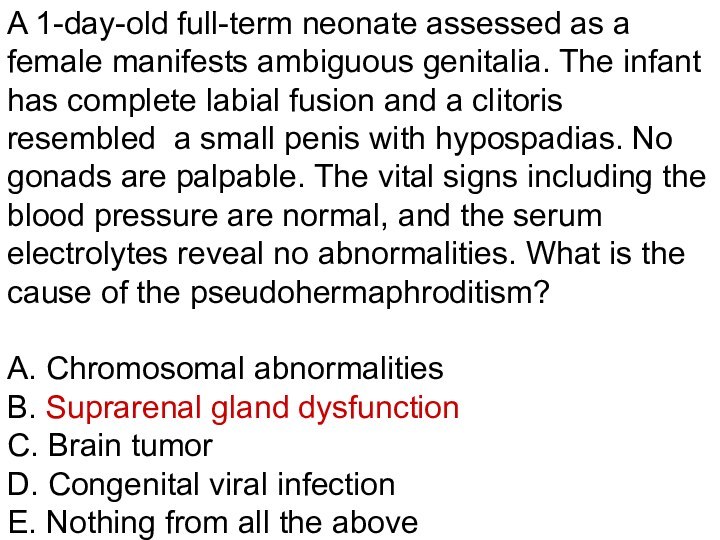
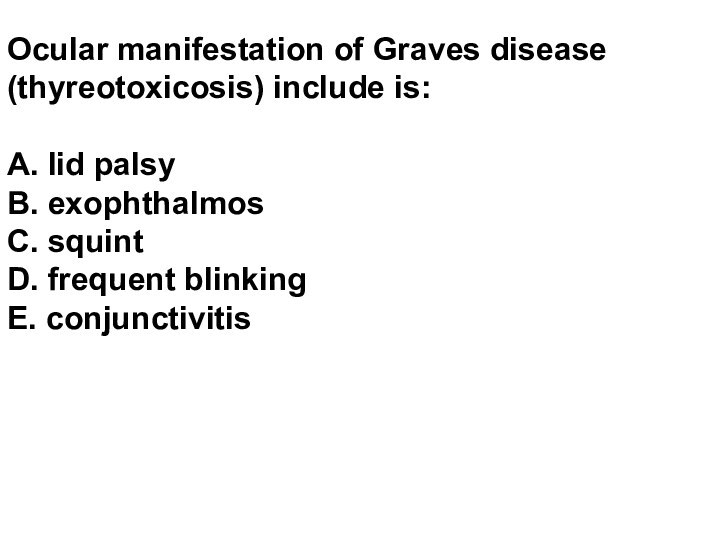
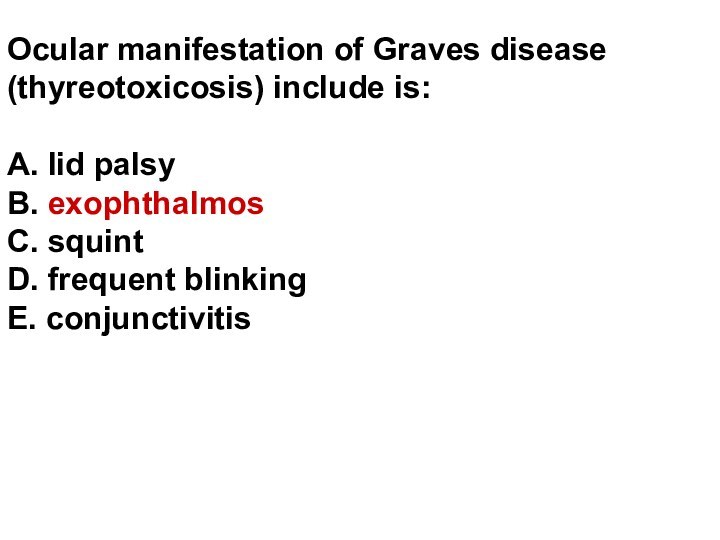
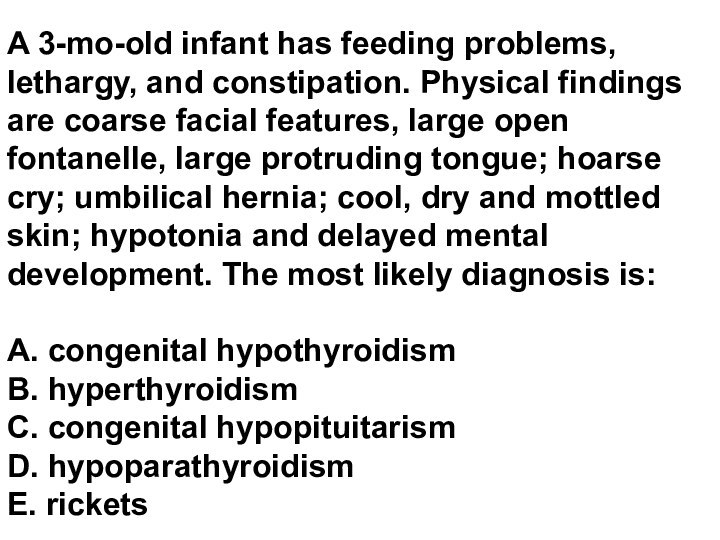

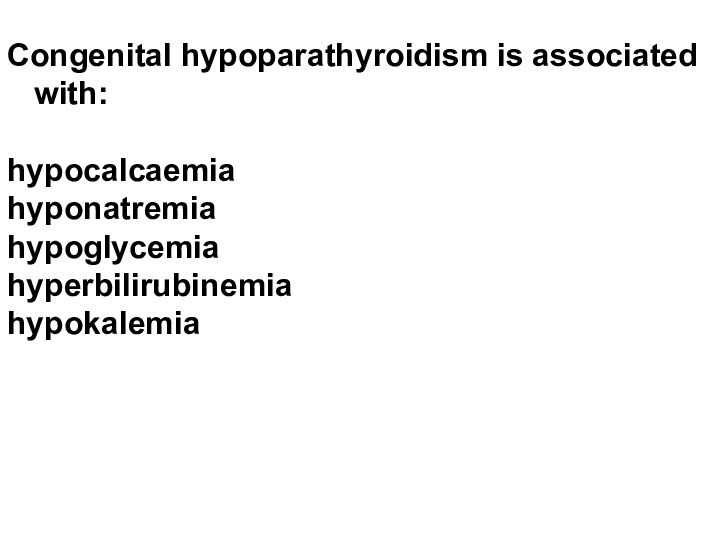
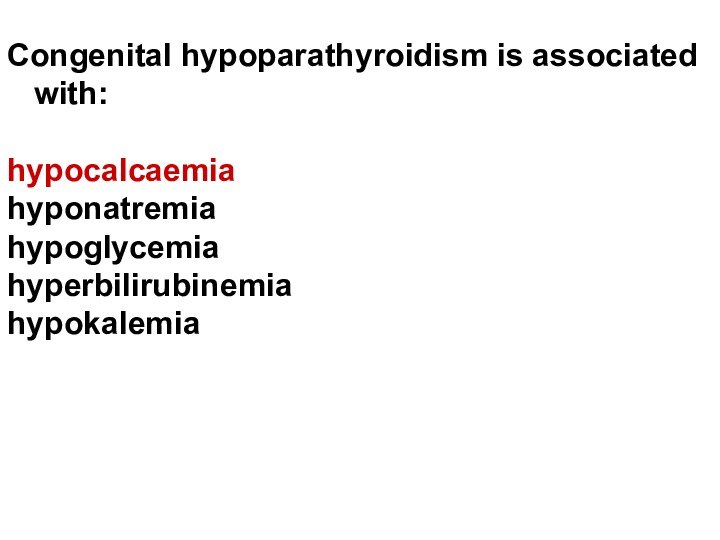
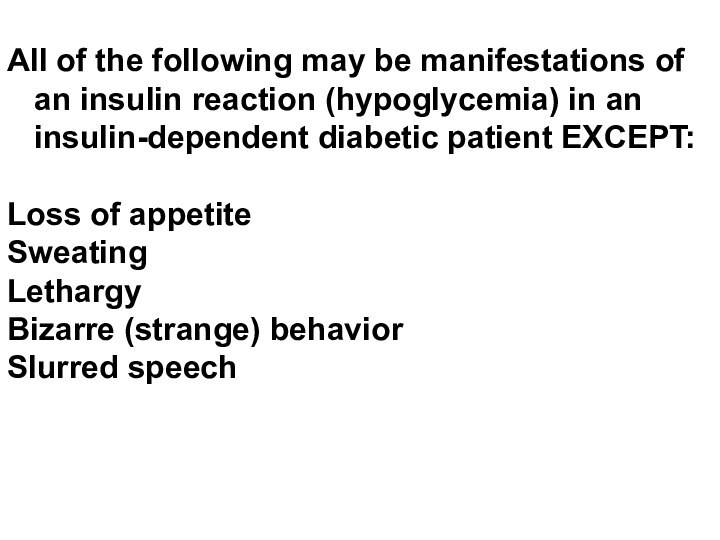

Слайд 3 Hormones are peculiar envoys, commands, coded by a
chemical way. Depending on composition of their nature they
can be peptides or steroids (derived from cholesterol). Peptide hormones react with specific receptors on the surface of cellular membranes. Steroid hormones react directly with DNA inside the cells, freeing the effects of genes with achievement of the proper effects.
Слайд 4
There is general conformity to the law of
the endocrine system action– as more hormones are excreted,
as much intensity of execution of organs’ and tissues’ function. Lack of hormone conduces to the function’s stop or its very low level.
Слайд 5
Organization of hormonal management in an organism is
based on doubling (a few hormones can approximately execute
similar aims), and counter- regulation: there are antagonistic counter-hormones.
Слайд 6
The feedback principle – in condition of disappearance
of necessity in strengthening of function automatically the intensity
of hormones making goes down or counter-hormones switch on.Слайд 7 Endocrine glands possessing an intra-secretory function include a
hypophysis (pituitary gland, pituitary cerebri), epiphysis (pineal gland), adrenal
(or suprarenal gland), thyroid gland (glandula thyroidea), parathyroid glands, thymus (thymic gland), pancreas, sexual glands (or gonades).
Слайд 8
Each of the endocrinal glands possesses a specific
function, but all of them are in close intercommunication
with each other and with CNS, providing unity of organism’s functions regulation, that is reflected in the often used term “neuroendocrine (neurohumoral) regulation”.
Слайд 9
The main organizing center which provides regulation in
the conditions of intensive stream of neuroendocrine impulses and
participates in feedbacks forming is hypothalamus.Слайд 10 Efficiency of hypothalamus` work is explained that it
is a part of brain and is regulated by
direct communications with the numerous neurons of CNS. In its turn the hypothalamus possesses by hormonal activity, synthesizes relysing-hormones which stimulate formation of hypophyseal hormones tropic to the endocrine glands. The functional state of endocrine glands, especially of hypothalamo-hypophysial «axis», has the enormous value for children, because determines their growth and development.
Слайд 11
The system of the endocrine regulation depends very
much on ability of cells and tissues` receptors to
react specifically in answer of the hormonal impulses.
Слайд 13
Most endocrine glands' organogenesis and the hypothalamus` formation
begin on 5 — 6th week of embryonic phase.
The hormonal synthesis begins after organogenesis' completion in the first trimester of pregnancy.Слайд 14 From positions of embryology it is necessary to
define the hypothalamus, hypophysis and epiphysis as derivative structures
of cerebrum. Thymus (thymic gland), thyroid and parathyroid glands are derivated from embrionic branchial pockets. Pancreas is formed from middle bowel's diverticulum of embryo. Adrenal glands` forming takes place together with the renal cortex. In the II trimester the participation of the systemic axis called hypothalamus - hypophysis - adrenal cortex is already expressed in regulator activity. At the moment of birth the hypophysis possesses distinct secretory activity, which is confirmed by a presence in the umbilical cord blood of fetus and newborn a high contents of ACTH. Functional activity of adrenal cortex in a prenatal period is also proved.Слайд 15 The fetal development especially on an early stage,
undoubtedly, is happening under close control of mother’s hormones
which a child gets with a placental blood and continues to get with motherly milk in postnatal period.Слайд 17 The endocrine diseases of mother with high concentrations
of hormones in blood can cause similar diseases in
a fetus and newborn (for example, thyrotoxicosis in newborns).Two male infants (twins) with neonatal congenital hyperthyroidis
Clinical features include lack of subcutaneous tissue and wide-eyed, anxious stare.
Слайд 18 In prenatal period the hypophysis and thymus achieve
the most anatomic and functional development.
After birth the
adrenal, pancreas, thyroid and parathyroid glans are advancing quickly while the hormonal activity of thymus is exposed to reverse fase. Teens - the turbulent development of sexual glands begins at onset of pubertal period. The definitive forming of them signifies ending of childhood and their age involution means old age coming.
Summary:
Слайд 19 The essence of endocrine regulation in human organism.
The hormonal system of regulation is organized by the
feedbacks. For example, thyreotropin-dismissive hormone of hypothalamus promotes making of anterior hypophysial lobe’s the thyroid-stimulating hormone (TSH, thyrotrophin, thyrotropic hormone) which in its turn stimulates making of thyroid hormones–triiodothyronine and thyroxin. The sufficient contents of thyroxin brakes hypothalamus and its stimulating function fades.
Слайд 20 Principles on which the clinical research of
endocrinal system is based on.
1/ Detection of signs and
syndromes which are characteristic of hyper- or hypoproduction of hormones in a patient.2/ Determination of hormones’ concentrations in blood serum, taking into consideration the principle of feedback. It means if the countent of eventual effectoring (tissue) hormone is low the simultaneouse increasing of hypophysial and hypothalamic fuction happens with proper tropic and releasing hormones production. (And vice versa).
Слайд 21 3/ Detection of abnormal organs’ and cells-targets’ reaction
for hormones (for instance, the feminizations` phenomenon in boys
having testicles with their development on a womanish type also called as a testicular feminization due to ignorans of body cells to react to testosterone).4/ Determination of endocrine glands' sizes and their other specifications.
The increase of endocrine gland in size is not necessarily accompanied by hormonal production increase. For example, in case of euthyroid goiter when there is the compensating increase of thyroid gland in size due to lack of iodine in food.
Слайд 22
Description of ductless glands in children, effects of
their hormones on organs and cells-targets, semiotics of insufficiency
or surplus of activity of endocrine glands.
Слайд 23
Hypothalamus.
Hypothalamus is the part of cerebral trunk and
simultaneously supreme organ in the system of feedbacks and
direct communications in the system of endocrine regulation. As a part of nervous system the hypothalamus participates in forming of major vegetative functions such as senses of hunger and thirst, maintenance of body temperature, arterial pressure, sweating (perspiration) and many others. At the same time as an organ of endocrine system the hypothalamus produces releasing hormones (factors) able to excite the hypophysial humeral production. It means that the hypothalamic hormones are mainly directed on target-cells of hypophysis.
Слайд 24
The innate structural abnormalities of hypothalamus, as a
rule, are not compatible with life. More frequently in
medical practice it is necessary to deal with the acquired diseases of hypothalamic area like a consequence (sequelle) of acute viral encephalitises.
Слайд 25
Semiotics of hypothalamic lesions.
The hypothalamic syndrome
(hypothalamic disfunction) proves by various vegetative disorders (like bulimia
or excessive appetite, unmotivational thirst, body temperature fluctuations which so-called as the fever related with CNS damege, asymmetry of perspiration, arterial hypertancion). In this cases appropriately there are disorders of many other endocrine glands. Their activity can be both increased and weakened as a result of hypothalamic disorders development. The patients' appearance often corresponds to severe obesity with surplus mass reaching up 200% and more over normal. It is so-called hypothalamic obesity. It develops very quickly after the inflammatory disease of CNS with the hypothalamic area lesion.
Слайд 26
Hypophysis (pituitary cerebri).
The pituitary gland is also derived
part of brain and its meninges. However the hypophysis
has all attributes of the independent endocrine gland. Its secrets penetrate into the blood reaching other endocrine glands and regulate their activity. Anatomically the pituitary gland is located in the bones` hollow on the skull basis’ internal surface called "turkish saddle" (lat. sella turcica).Слайд 27 The anterior hypophysial lobe (anterior pituitary) produces several
tropic peptide hormones. They are the somatotropic hormone (STH,
somatotropin) or growth stimulating hormone, adrenocorticotropic hormone (ACTH), which stimulates adrenal cortecal hormones` production, thyrotropic (TSH) and gonadotropics (GTH) hormones.Слайд 28 What is the physiological role of STH in
childhood period?
In postnatal period the STH is the
main metabolic factor influencing on all types of metabolism. Under its action directly in body tissues the factor of growing similar to insulin is forming up which biological role consists in ensuring of body growing up and maturation as biological phenomena pro se.Слайд 29 The posterior hypophysial lobe (posterior pituitary) is anatomically
closely connected with hypothalamus (hypothalamo - hypophysial axis-system). The
posterior hypophysial lobe is the main producer of oxytocin which intensifies contraction of womb and mammary ducts in breast in nurses women and vasopressin (antidiuretic hormone - ADH) which takes part in regulation of the water balance in any ages. The regulation of ADH syntheses and its coming in blood are controlled by hypothalamus.
Слайд 31
The anterior hypophysial lobe’s hyperfunction (commonly due
to adenoma) occures like a rare disease. The adenoma
shows itself by high values of STH and pathological influences upon the growth. It leads to hypophysial giantism (do not mix up with family tall stature!). The anterior lobe hormonal active adenoma of pituitary gland’s with high level of STH content in blood develops mostly in teenagers and adult persons. In these patients the definitive body length alredy has achived and people can not grouth up more. Equal to abnormal grouth in patients with pituitary hyperactive adenoma in clinical practice this condition leads to acromegalia. The acromegalia is nominated as an unusual increasing of the limbs in their distal parts and face (nose, lips etc.).Слайд 32 Cerebral gigantism in an 8-yr-old boy. The height
age was 12 yr; the bone age was 12
yr; IQ was 60.Notice the prominence of the forehead and the jaw and the large hands and feet.
The adult height is 208 cm. He wears size 48 shoes.
Слайд 33 If the hormonal active adenoma of anterior lobe
of pituitary gland is accompanied by hyperproduction of ACTH
it leads to hypophysial form of Cushing’s disease. The Cushing’s disease or syndrome is characterised by high levels of serum gluco- and mineralocorticoids in plasma. There are also symptoms of hyperglycemia, “similar to buffalo” type of obesity, hypernatremia, hypokalemia, arterial hypertension and edematouse skin.Слайд 34 The hypofunction of anterior lobe of pituitary gland
usually proves itself by concentrational decrease of STH, insulin
like growth factor and gonadotropic hormone (GTH). The condition causes the hypophysial proportional dwarfism (nanism) with delay of sexual developement.Слайд 35 The common functional disturbances of anterior hypophysis can
provoke disturbance touch all sides of gland’s activity. This
syndrome is called as dispituitarism and quite often it appears only in teens.Слайд 36 Hypophysail posterior lobe’s dysfunction. Due to insufficient production
of ADH the symptoms of pathological polyuria and polydipsia
(diabetes insipidus) develop in condition of absence of hyperglycemia and glucosuria.
Слайд 37
Objective visiul stady of the pituitary gland is
possible observing size of the sella turcica on lateral
roentgenogram of the skull. This is one of visualising methods in endocrinology and is broadly used in clinical endocrinologic practice.Слайд 38 Roentgenograph of the skull of a
9-yr-old boy with polydipsia, polyuria, nocturia, and enuresis. Urine
specific gravity was 1.010 after water deprivation. Growth was normal, and the sella turcica was considered roentgenographically to be at the upper limit of normal but was probably enlarged. Over the ensuing 6 mo, the symptoms of diabetes insipidus abated.The patient returned at 14 yr of age because of growth failure and delay in sexual maturation. Studies revealed a deficiency of growth hormone, gonadotropins, corticotropin, and thyrotropin. Note the enlargement of the sella turcica. There was exacerbation of diabetes insipidus with the administration of hydrocortisone and thyroxine. At surgery, a large craniopharyngioma was found.
Слайд 39
Adrenal glands
Adrenal cortex produces more than 60
biologically active materials and tissues` hormones of steroid nature,
which because of their influence on metabolism are divided on glucocorticoids (cortisone), mineralocorticoids (aldosteron, 11-desoxycorticosterone) and sexual hormones - androgens (17-ketosteroids and testosterone) and very small concentrations of female sexual hormones – estrogens (for example, estradiol).Слайд 40 The production of cortico - and mineralocorticosteroids are
found under control of hypophysial ACTH and interconnected with
it. These hormones provide the catabolic effects releasing energy, possess an antistressal and immunoregulating properties. The mineralocorticoids participate in regulation of fluids and sults balance. They predispose to delay of sodium and remove the potassium.Слайд 41 The role of adrenal glands’ sexual hormones is
especially important in prenatal period. This role consists in
forming of primary sexual signs which differentiate phenotypically children on boys and girls.In period of human life since the birth till adolescens the small amouts of adrenal sexual hormones regulate only anabolic reaction and support the growing. The bodies of children in their 8-9 years practically do not differ too much in boys and girls. The genitalias formed according to genotypical sign are an exception.
Слайд 42 At the beginning of pubertal stage (approximately in
11 years old girls and 13 years boys) obeying
to hypothalamic and hypophysial humoral signals the adrenal glands react by transitory increasing of adrenal male gonadial hormone production (testosterone) both in boys and in girls. The body transformation cascade of sexual puberty starts. First of all the pubarche (growing of lean light hair on pubis) appears.Subsequently only the sexual glands’ activity for all time of sexual puberty will provide forming of secondary sexual signs.
After the age dependant involution of gonades the adrenals again will become a source of testosterone like in early childhood and this hormone will maintaine the anabolic reactions in olderness.
Слайд 43
Semiotics of adrenal cortex’ lesion
About adrenal cortex’
activity the clinicians consider basing on ACTH, corticosteroids’, mineralocorticoids’
contents in blood, on serum potassium, sodium and chloride which disturbans should be indirect signs of hypo- or hyperaldosteronism, on concentrations of 17- ketosteroids in urine, on Cushing’s, Addison’s symptoms performance, on correctness of external genitalia’ forming in girls (subjects with genotype 46, XX), on possible signs of premature puberty in boys and girls.
Слайд 44
The acute adrenal insufficiency syndrome
The signs are
weak and rapid pulse, arterial hypotention, hypoglycemia, bluish spotted
skin (livedo).The chronic suprarenal insufficiency (Addison’s disease)
The signs are the weight losing, edvanced muscular weakness, peculiar brownish skin colouration on abdomen, on area of genitalia and joints (“bronze disease”). The serum hyponatremia and hyperkalemia are characteristic.Both for acute and for chronic forms of adrenal insufficiency it is characteristic of serum low levels of glucocorticoids and mineralocorticoids. Besides, for chronic form of insufficiency it is typical of high concentration of serum ACTH as result of futile pituitary`s signals to intensify the suprarenals` function.
Слайд 45 The abnormally increased function of adrenal cortex with
hypersecretion of glucocorticoids, androgens and partly mineralocorticoids cause the
suprarenal form of the Cushing’s syndrome. In children this condition develops basically as a result of adrenal cortexs’ hormonal active tumor. In these cases the level of ACTH in plasma is low.Слайд 46 The genetically determined disturbances with hyperproduction of 17-
ketosteroides (testosterones` line) by suprarenal glands, possible, with simultaneous
deficit of mineralo- and gluco-corticoids in plasma.The affected children develops so-called adreno-genital syndrome. The clinical pattern of syndrome is the most tipical in girls. In them the external genitails’ virilization can occur in children even in utero. The external genitalias are getting masculine: the clitoris hypertrophies and labia becomes to look like a scrotum. The sex determination in newborn becomes difficult. Some forms of adreno-genital syndrome are accompanied with lack of mineralocorticoids and phenomenon of sodium loss with urine and severe vomiting. The affected children are getting dehydrated.
Слайд 48 In elder age (between 3 and 8 years
in girls and 3 - 11 years in boys)
the symptoms of late adreno-genital syndrome are the virilization in girls and premature (precox) puberty both in girls and in boys.A 6-yr-old girl with congenital adrenal hyperplasia. The urinary 17-ketosteroids were high (50 mg/24 hr).
B. Notice the clitoral enlargement and labial fusion.
Five-yr-old brother was not considered to be abnormal by the parents. The urinary 17-ketosteroids were also high (36 mg/24 hr).
Слайд 49 Semiotics of selective lesion of suprarenal medulla.
The main hormones of adrenal medulla are adrenaline and
noradrenaline. They influence on the level of arterial blood pressure and regulate adaptive reactions in stress. The pheochromocytoma (hormone-active tumor of suprarenal medulla) is a rare in children disease and is characterized by severe attacks of arterial hypertension due to hypercatecholaminemia. The laboratory studies reveal the high levels of adrenaline, noradrenaline and/or their metabolities in blood and urine.
Слайд 50
Thyroid gland
The thyroid gland synthesizes two main
hormones: triiodothyronine (T3) and thyroxin (T4). These hormones are
regulators of basic metabolism, consequently, determine child’s growing and influence on excitability of nervious system. The function of thyroid gland is closely connected with pituitary gland function which adjusts its activity on feedbacks’ principle using TSH.
Слайд 51
Thyroid gland functional insufficiency
Thyroid gland functional insufficiency
or hypothyroidism is one of the most frequent endocrine
diseases in children. The hypothyroidism can develop as an innate or acquired disease. It can be caused by congenital aplasia of thyroid gland or acquired lesion. The size of the gland can be normal or enlarged (the goiter or struma).
Слайд 52
The clinical manifestations of congenital hypothyroidism appear in
neonatal period or early infancy in form of the
cretinism.The cretinism means the dwarfism with mental retardation.
Early manifestation in neonatal period include:
feeding difficulties (lack of interest and choking spells;
respiratory difficulties (nasal obstruction or labored and noisy respiration;
prolonged physiological jaundice as an important sign for suspicion.
Слайд 53
The late symptoms of innate hypothyroidism, as
a rule, are the result of late diagnosis. The
affected children start to loss an intellect and coarse features of appearance are getting evident.The coarse features are: large head, coarse hair, low anterior hair line, wrinkled forehead, swollen eye lids and thick protruded tongue. Sometimes the hoarse voice attracts attention on. The umbilical hernia is present. Simultaneously the motor (the child does not head support, delayed sitting, standing) and mental (does not smile, laughing, recognize of mother etc.) delay is progressing.
Слайд 54 Congenital hypothyroidism in an infant 6 mo of
age. The infant fed poorly in the neonatal period
and was constipated. She had a persistent nasal discharge and a large tongue; she was very lethargic; and she had no social smile and no head control.
A.Notice the puffy face, dull expression, and hirsute forehead. Osseous development was that of a newborn.
B. Four mo after treatment, notice the decreased puffiness of the face, the decreased hirsutism of the forehead, and the alert appearance.
Слайд 55 Among additional confirmatory investigations the X-Ray symptome of
bone ossification delay is important. In infants suspected as
hypothyroid it is enough to make the rontgenologic study of knee joint. The lag of hip epiphysises ossification means that hypotireoidism started before childs` delivery.Congenital hypothyroidism:
Absence of distal femoral epiphysis in a 3-mo-old infant who was born at term. This is evidence for the onset of the hypothyroid state during fetal life.
Слайд 56 Rickets in a 2-year-old child presenting with bowing
of legs, abnormal gait, and associated hypotonia. The condition
has to be differentiated with infantile cretinismus. Note prominence of wrists and lower femoral epiphyses.
Слайд 57
The laboratory study confirms the diagnosis. The serum
concentration of TSH is increased and T3, T4 are
decreased.Слайд 58 Hyperthiroidisms (exophthalmic goitre, Graves’ disease, thireotoxicosis and other
names). The symptoms are emotional lability, hyperperspiration, fever, arterial
hypertension, typical nails and ocular symptoms. The laboratory studies reveal low level of TSH and simultaneously high serum concentrations of T3 and/or T4.Слайд 60 The sizes and other characteristics of thyroid gland
should be estimated by visual examination and palpation. The
enlargement of thyroid gland is called goiter or struma. The goiter can develop in utero and cause the severe disturbances of breathing (respiratory distress) in newborn.
Слайд 61
Parathyroid glands
Parathyroid glands are derived from branchial
pockets, shaping in embryo simultaneously with thymic gland and
arc of aorta. So the embryopathies of these organs are often combined.The parathormone which synthesis occurs in parathyroid glands participates together with vitamin D in regulation of phosphoric-calcium metabolism. The function of parathyroid glands is autonomous and does not controlled by pituitary gland.
Слайд 62 Functional insufficiency of parathyroid glands (due to their
aplasia, damages in labour or as a result of
excessive surgery operation on thyroid gland) results in hypocalcemia and hyperphosphatemia. This condition is characterized by high neuro-muscular excitability and even spasmophilia. The last one manifests itself spontaneously and/or after mechanical irritation of periftral nervous showing involuntary muscular spasms possible as well as to generalize on maneure of tonic cramps (spasms). Hypocalcemic cramps as a rule does not accompany by loss of consciousness like a typic brein-releted.
Слайд 63
Innate hyperparathyroidism is accompanied by hypercalcemia with nephrocalcinosis
development and nephrolitiasis in urine tract (renal pelvis and
urinary bladder).Слайд 64 The hypertrophy (hyperplasia) of thymus if it is
revealed in young children on routine chest X-Ray is
frequent benign sign and reflects individual feature of childs` physiology. As a rule it is not connected with pathological conditions. In many cases the rengenological enlargement of thymus does not mean thimic hyperfunctional condition. Now the pediatricions do not take this sign in account.
Thymic "sail sign".
Слайд 65
Epiphysis (pineal gland).
In children the epiphysis (breins`
derived gland) has biger size than in adult persons.
It works out the hormones influencing upon common gonadial cycle, lactation, carbohydrates` metabolism and water-salts regulation. The epiphyseal activity correlates with account of leukocytes in blood. The clinical importance of epiphyseal disfunction is not studied enough yet.
Слайд 66
Pancreas
Pancreas as an organ of endocrinal system
works out insulin and glucagon. They act like antipods
and adjust the level of glucose in blood and its utilization by body` cells. The insufficient production of insulin as a result of pancreas’ insulin-producting cells’ destruction in children is known as a diabetes mellitus of the first (juvenile) type. The symptoms of recently appeared and progressing juvenile diabetes mellitus are connected with hyperglycaemia (abnormally high level of glucose in blood) and cells` impossibility to assimilate glucose from the blood. This is only list of these symptoms: hyperglycaemia, glucosuria, polyuria due to osmotic diuretic effect of glucosuria, relentless thirst and hunger, polydipsia and polyphagia, dehydration, severe metabolic disturbances leading to cerebral coma.
Слайд 67
Gonadial glands development and puberty.
Boys’ puberty.
The main hormone of testicles is testosterone. It
pertains to anabolic steroids, activates the growing, muscular tissue developement, dexterity and muscles power peculiar to male nature. Testosteron causes the cascade of body changes in boys residing in the 1-st stage of sexual development according to JM. Tanner, when boys’ and girls’ bodies extraordinary remind each other. The secondary sexual signs gradually are forming and spermatogenesis begins.
Слайд 69
Sex maturity ratings of pubic hair development in
adolescent boys. (By JM Tanner, M.D., Institute of Child
Health, Department of Growth and Development, University of London, London, England.)
Слайд 70
Puberty in girls.
Period of puberty in girls is
characterized by gradual body changes occurring due to influence
of gonadial hormone - estradiol.Слайд 71 The girls aged approximately 14,5 - 15 years
reach the definitive rate of sexual maturity (Ah 3,
Pu 5, Ma 5). In this age 100% of girls regularly menstruate.Слайд 72 What parts of the hypophysis (pituitary) do you
know?
anterior and posterior
medial and lateral
small and large
black
and whiteright lobe and left lobe
Слайд 73 What parts of the hypophysis (pituitary) do you
know?
anterior and posterior
medial and lateral
small and large
black
and whiteright lobe and left lobe
Слайд 74
What hormone does the thyroid gland secrete?
T4
- thyroxine
TSH – Thyroid stimulating hormone, thyrotropin
Aldosterone
vasopressin
insulin
Слайд 75
What hormone does the thyroid gland secrete?
T4
- thyroxine
TSH – Thyroid stimulating hormone, thyrotropin
Aldosterone
vasopressin
insulin
Слайд 76 Which hormone is secreted by the hypothalamus and
stored in the posterior lobe of the pituitary gland;
reduce urine production by increasing the water reabsorption in the renal tubules?Somatotropic
thyrotropic
antidiuretic
adrenocorticotropic
follicle-stimulating
Слайд 77 Which hormone is secreted by the hypothalamus and
stored in the posterior lobe of the pituitary gland;
reduce urine production by increasing the water reabsorption in the renal tubules?Somatotropic
thyrotropic
antidiuretic
adrenocorticotropic
follicle-stimulating
Слайд 78
Adrenal medulla produces:
А. Adrenalin
В. Noradrenalin
С.
Dopamine
D. All of the above
Е. All of the
above and aldosterone
Слайд 79
Adrenal medulla produces:
А. Adrenalin
В. Noradrenalin
С.
Dopamine
D. All of the above
Е. All of the
above and aldosteroneСлайд 80 In children with congenital hypothyroidism the serum blood
tests reveal:
decreased ТSH
Increased ТSH
Increased Т3
increased Т4
decreased ТSH, Т3, Т4
Слайд 81 In children with congenital hypothyroidism the serum blood
tests reveal:
decreased ТSH
Increased ТSH
Increased Т3
increased Т4
decreased ТSH, Т3, Т4
Слайд 82 A 1-day-old full-term neonate assessed as a female
manifests ambiguous genitalia. The infant has complete labial fusion
and a clitoris resembled a small penis with hypospadias. No gonads are palpable. The vital signs including the blood pressure are normal, and the serum electrolytes reveal no abnormalities. What is the cause of the pseudohermaphroditism?A. Chromosomal abnormalities
B. Suprarenal gland dysfunction
C. Brain tumor
D. Congenital viral infection
E. Nothing from all the above
Слайд 83 A 1-day-old full-term neonate assessed as a female
manifests ambiguous genitalia. The infant has complete labial fusion
and a clitoris resembled a small penis with hypospadias. No gonads are palpable. The vital signs including the blood pressure are normal, and the serum electrolytes reveal no abnormalities. What is the cause of the pseudohermaphroditism?A. Chromosomal abnormalities
B. Suprarenal gland dysfunction
C. Brain tumor
D. Congenital viral infection
E. Nothing from all the above
Слайд 84
Ocular manifestation of Graves disease (thyreotoxicosis) include is:
A.
lid palsy
B. exophthalmos
C. squint
D. frequent blinking
E. conjunctivitis
Слайд 85
Ocular manifestation of Graves disease (thyreotoxicosis) include is:
A.
lid palsy
B. exophthalmos
C. squint
D. frequent blinking
E. conjunctivitis
Слайд 86 A 3-mo-old infant has feeding problems, lethargy, and
constipation. Physical findings are coarse facial features, large open
fontanelle, large protruding tongue; hoarse cry; umbilical hernia; cool, dry and mottled skin; hypotonia and delayed mental development. The most likely diagnosis is:А. congenital hypothyroidism
В. hyperthyroidism
С. congenital hypopituitarism
D. hypoparathyroidism
Е. rickets
Слайд 87 A 3-mo-old infant has feeding problems, lethargy, and
constipation. Physical findings are coarse facial features, large open
fontanelle, large protruding tongue; hoarse cry; umbilical hernia; cool, dry and mottled skin; hypotonia and delayed mental development. The most likely diagnosis is:А. congenital hypothyroidism
В. hyperthyroidism
С. congenital hypopituitarism
D. hypoparathyroidism
Е. rickets
Слайд 88
Congenital hypoparathyroidism is associated with:
hypocalcaemia
hyponatremia
hypoglycemia
hyperbilirubinemia
hypokalemia
Слайд 89
Congenital hypoparathyroidism is associated with:
hypocalcaemia
hyponatremia
hypoglycemia
hyperbilirubinemia
hypokalemia
Слайд 90 All of the following may be manifestations of
an insulin reaction (hypoglycemia) in an insulin-dependent diabetic patient
EXCEPT:Loss of appetite
Sweating
Lethargy
Bizarre (strange) behavior
Slurred speech


